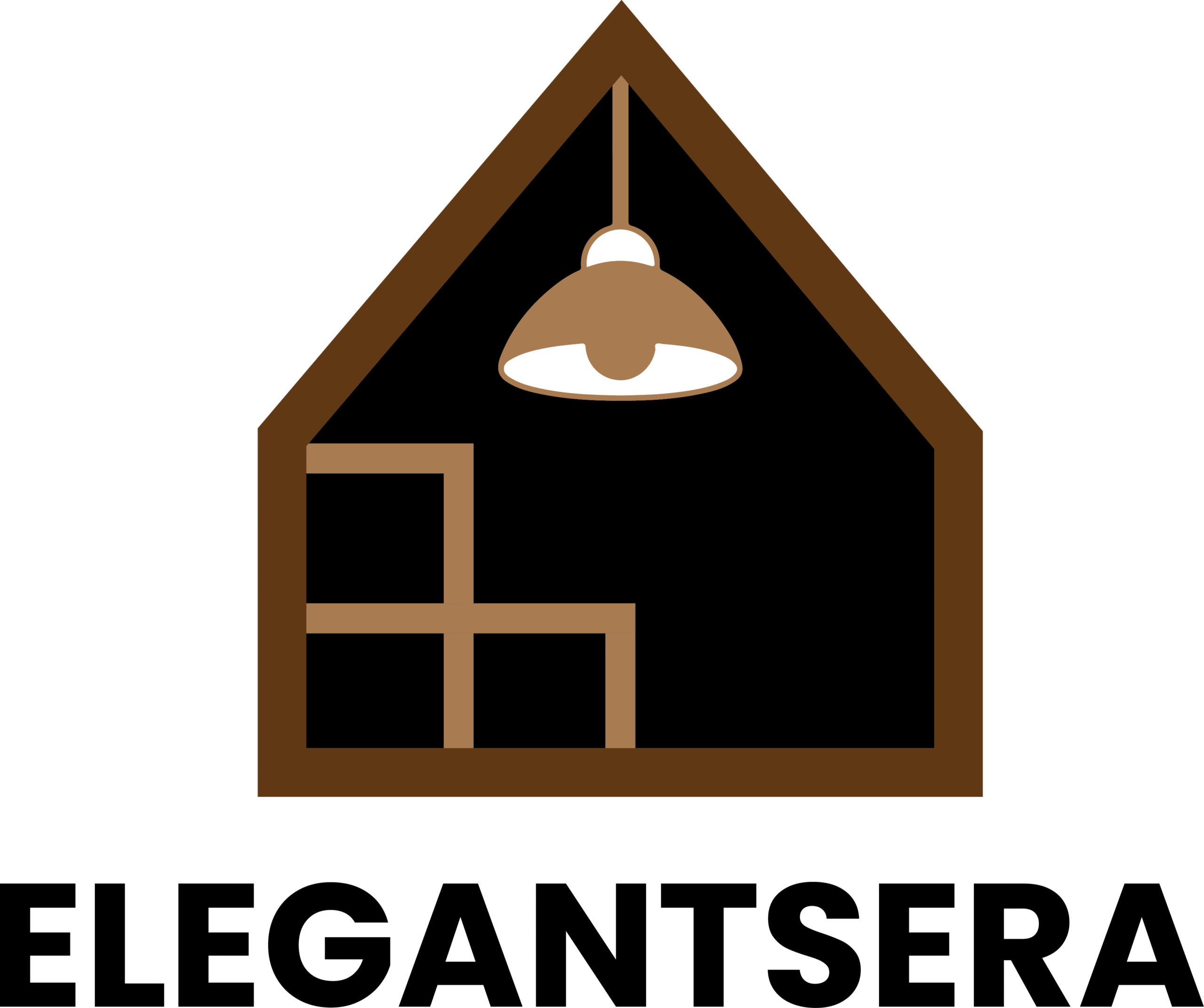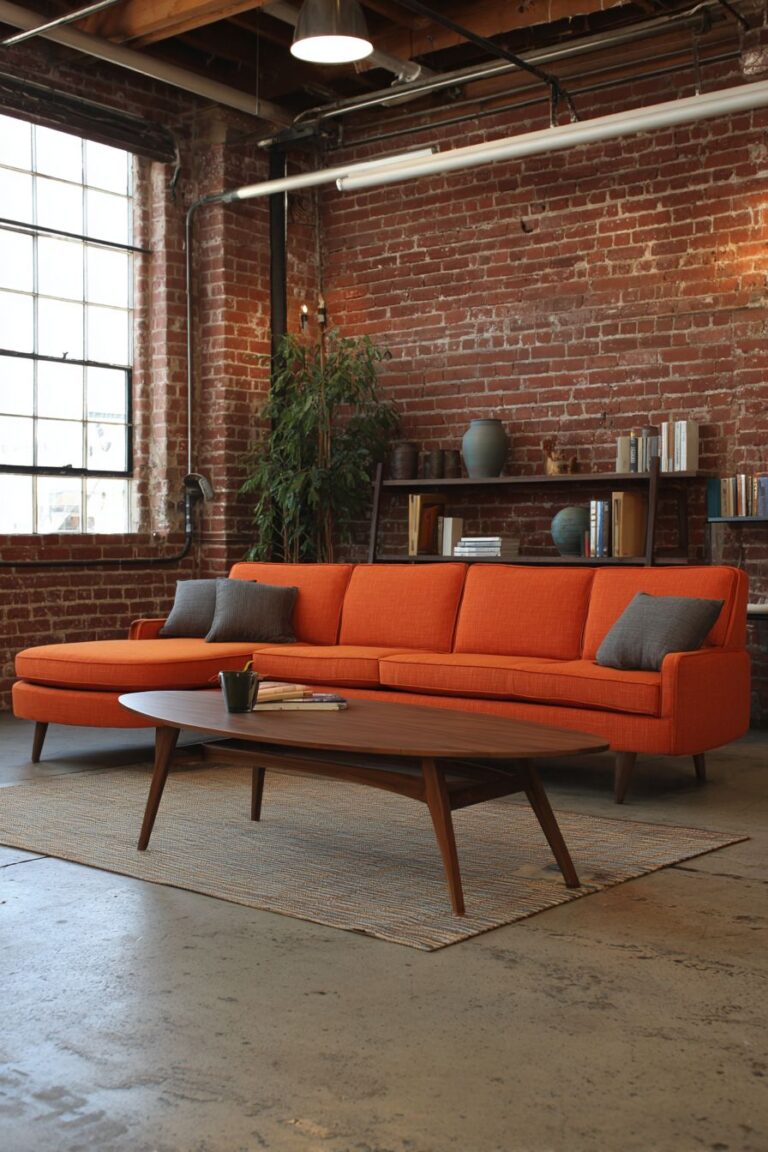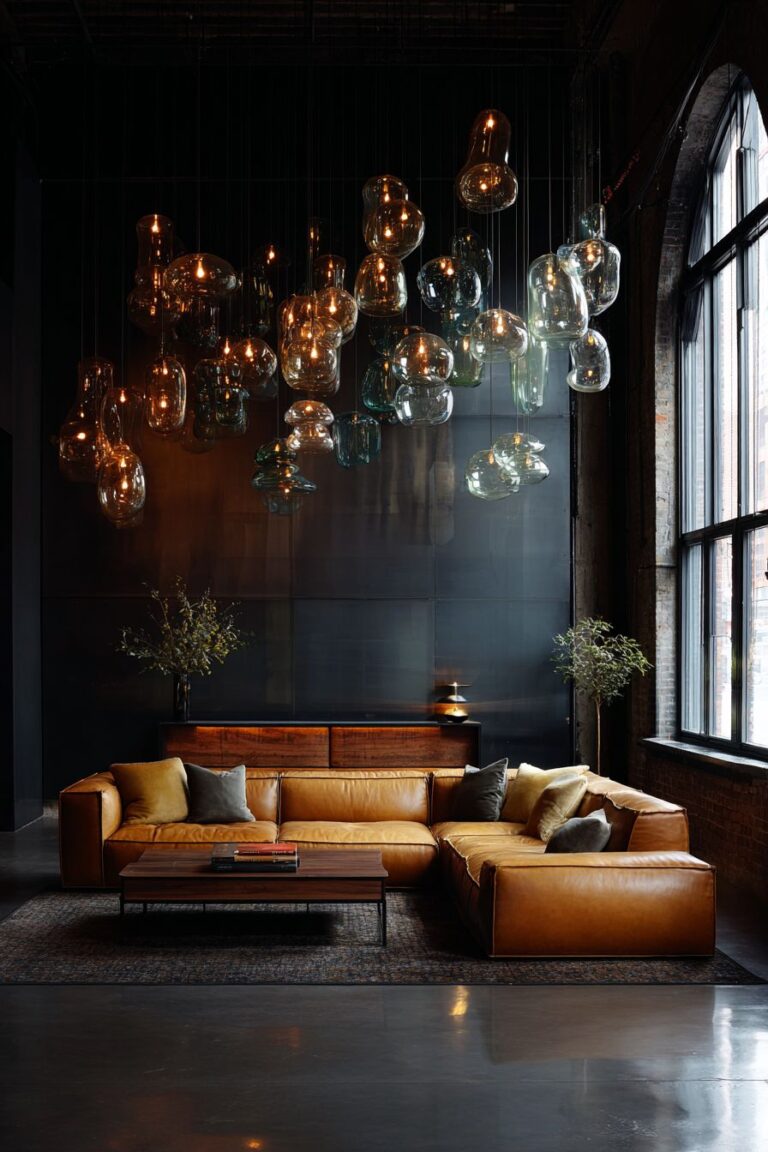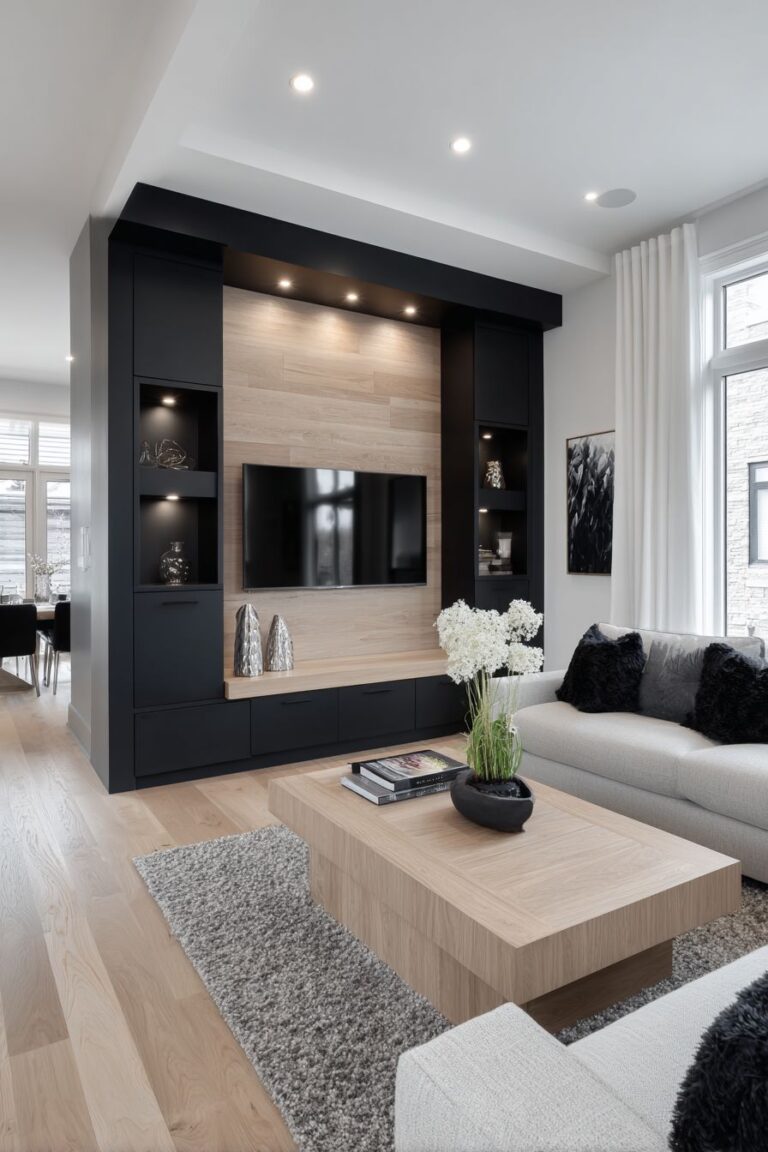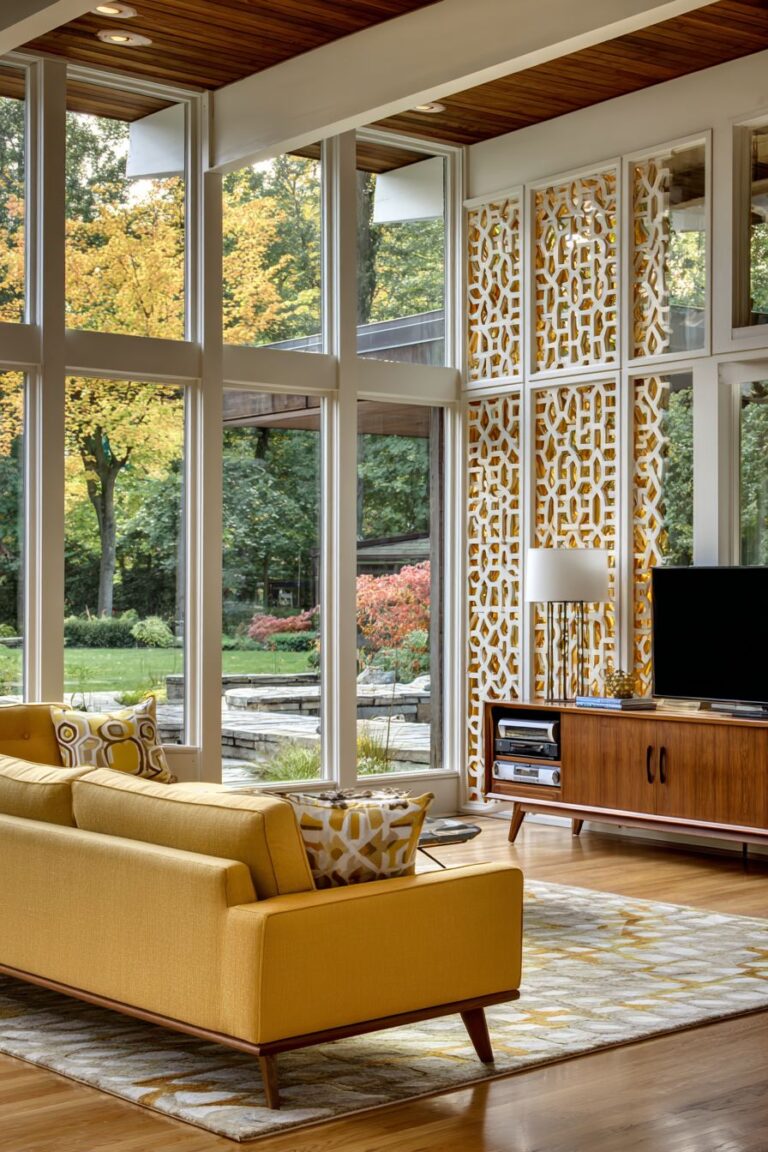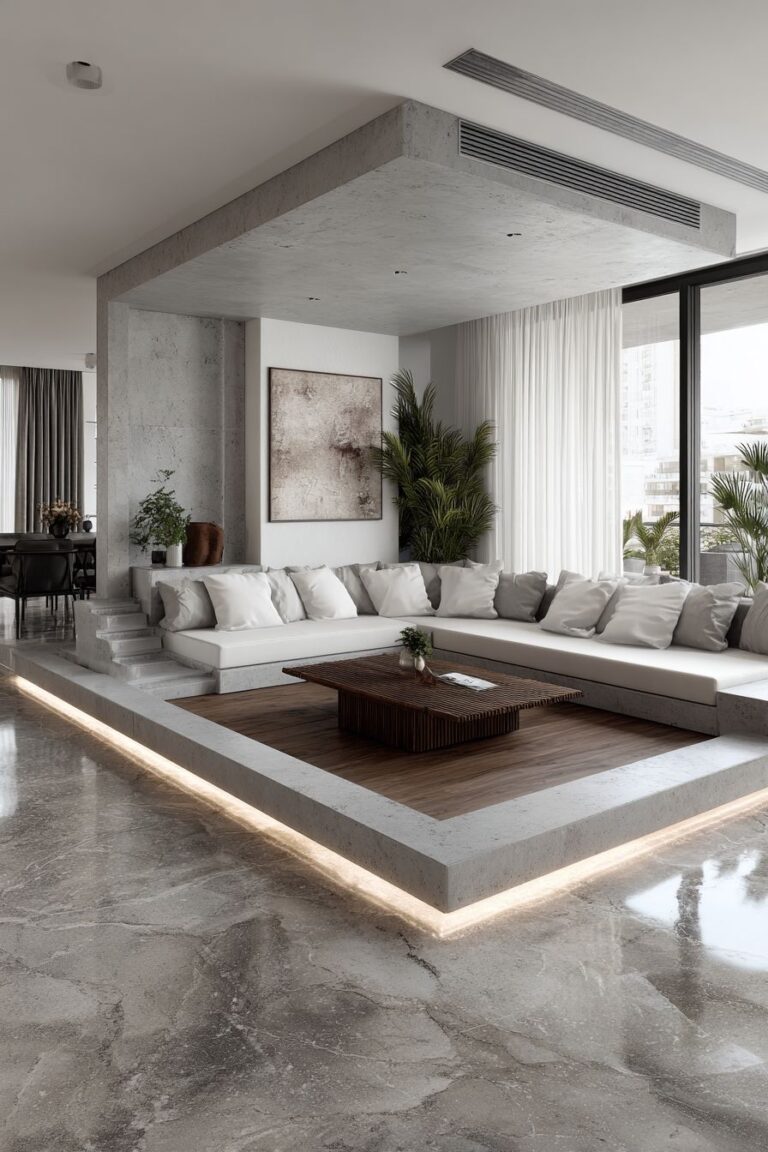20 Stunning Home Living Room Ideas to Transform Your Space
The living room serves as the heart of every home, where families gather, guests are entertained, and memories are made. This essential space reflects our personal style while providing comfort and functionality for daily life. A thoughtfully designed living room can elevate your entire home’s atmosphere, creating an environment that nurtures both relaxation and social connection.
Interior design has evolved tremendously over the years, offering homeowners an incredible array of styles, materials, and approaches to create their perfect living space. From the clean lines of Scandinavian minimalism to the rich textures of bohemian eclecticism, each design philosophy brings unique benefits and appeals to different personalities and lifestyles. The key lies in understanding how various elements work together to create harmony, functionality, and visual appeal.
In this comprehensive guide, we’ll explore 20 distinct living room design concepts that showcase the versatility and potential of this important space. Each concept offers a different approach to color, texture, lighting, and spatial arrangement, providing inspiration for homeowners seeking to refresh their living areas. Whether you’re drawn to industrial rawness, coastal serenity, or mid-century sophistication, you’ll discover practical insights and design strategies to bring your vision to life.
1. Scandinavian Serenity: Light and Natural Living

The Scandinavian living room embodies the philosophy of hygge – that Danish concept of cozy contentment that has captivated design enthusiasts worldwide. This design approach centers around a light grey linen sectional sofa with natural oak wooden legs, creating an anchoring piece that balances comfort with understated elegance. The natural materials speak to the Scandinavian reverence for craftsmanship and sustainability, while the neutral palette promotes a sense of calm and spaciousness.
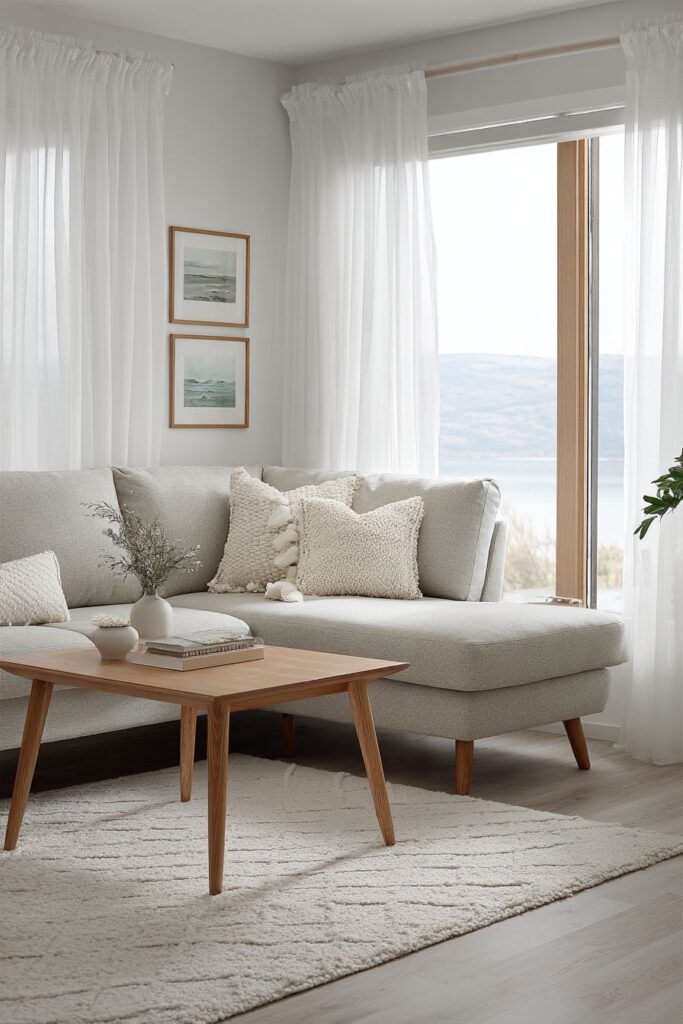
The matching oak coffee table with clean, geometric lines serves as both a functional surface and a testament to Scandinavian design principles. Its placement on a cream wool area rug with subtle geometric patterns adds warmth underfoot while maintaining the room’s minimalist aesthetic. The geometric pattern provides visual interest without overwhelming the space, demonstrating how thoughtful details can enhance rather than complicate a design scheme.

Floor-to-ceiling windows dressed with sheer white curtains maximize natural light – a crucial element in Scandinavian interiors where long winter months make every ray of sunshine precious. The white painted walls serve as a canvas for minimal artwork in natural wood frames, allowing each piece to breathe and command attention. This restrained approach to decoration ensures that the space feels curated rather than cluttered.
The overall effect is a living room that feels like a peaceful retreat from the modern world’s chaos. The combination of natural materials, neutral colors, and abundant light creates an atmosphere that promotes both relaxation and clarity of thought. This design approach proves that luxury doesn’t require ostentation – sometimes the most sophisticated spaces are those that appear effortlessly simple.

Key Design Tips:
- Choose furniture with clean lines and natural materials like oak and linen
- Maximize natural light with sheer window treatments
- Stick to a neutral color palette with whites, greys, and natural wood tones
- Select minimal artwork that complements rather than competes with the overall aesthetic
- Incorporate subtle geometric patterns through textiles for visual interest
2. Modern Minimalism: The Art of Less
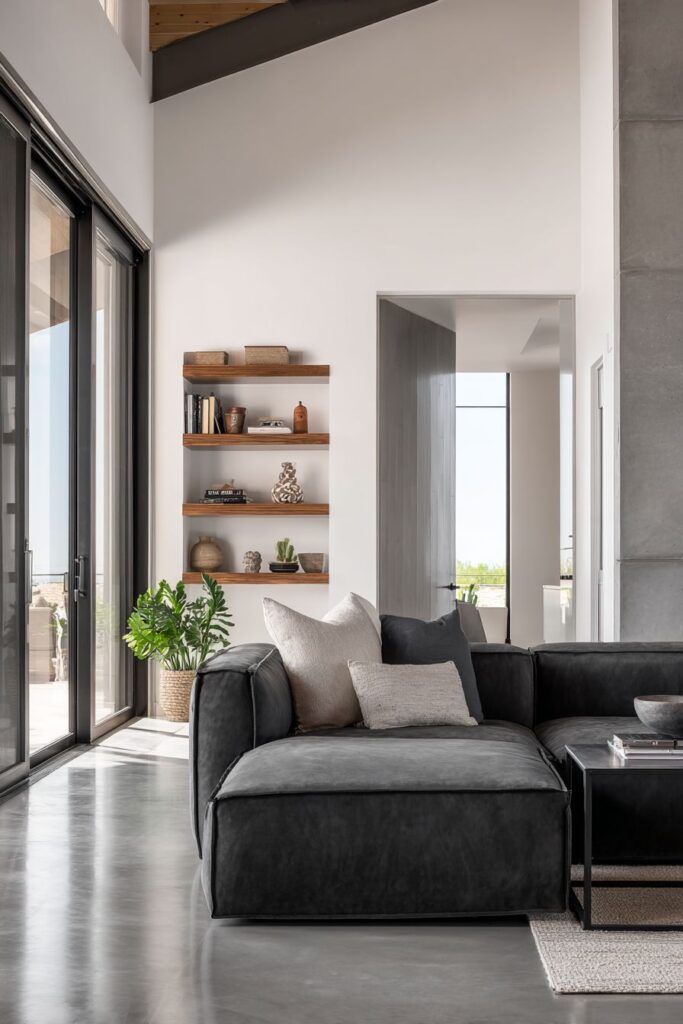
Modern minimalist design takes the concept of “less is more” to its logical conclusion, creating a living space that feels both sophisticated and serene. The charcoal grey modular sofa positioned against a pristine white accent wall serves as a study in contrast, demonstrating how strategic color placement can create visual impact without relying on busy patterns or excessive decoration. The modular nature of the sofa also speaks to modern living’s need for flexibility and adaptability.
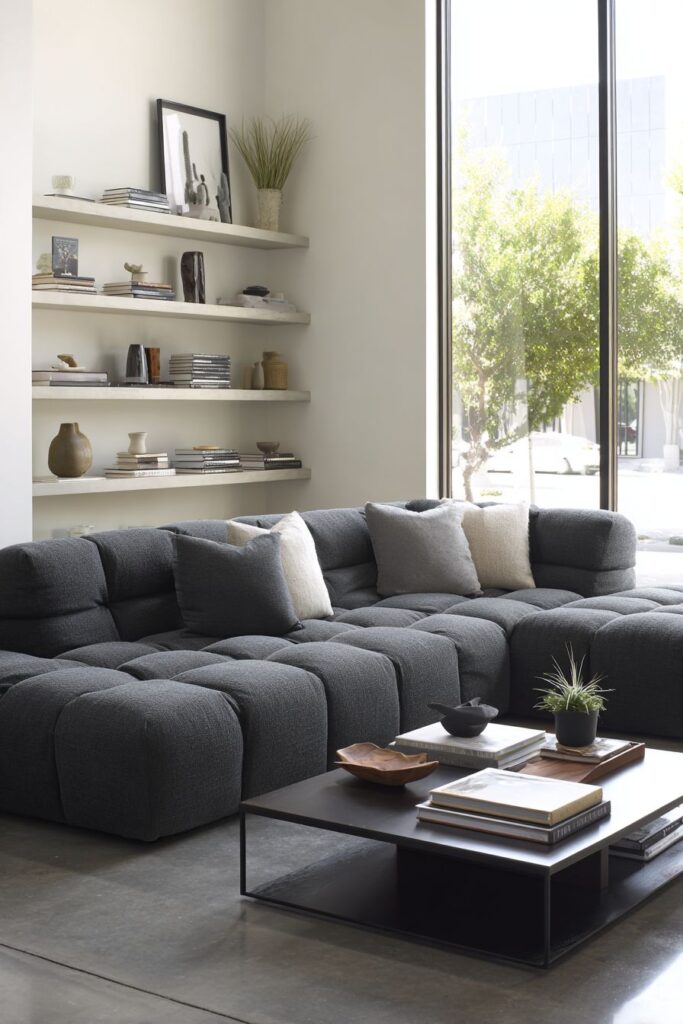
The sleek black metal and glass coffee table exemplifies minimalist design principles, where every element serves both form and function. Its transparent glass top maintains visual lightness while the black metal frame provides structural strength and adds an industrial edge. The polished concrete floors with radiant heating patterns create a seamless surface that’s both beautiful and practical, eliminating the need for additional floor coverings while providing comfortable warmth.
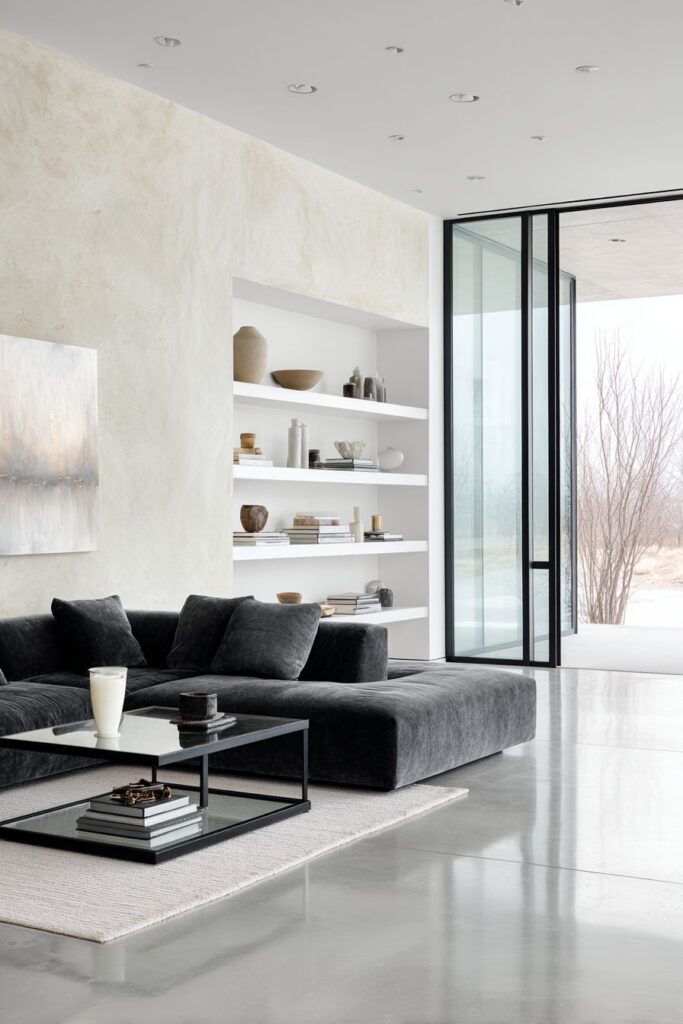
Built-in floating shelves offer storage and display opportunities without cluttering the visual field. These shelves showcase carefully curated books and ceramics, each item chosen not just for its utility but for its contribution to the overall aesthetic. The discipline required to maintain such spaces is part of their appeal – they encourage mindful living and intentional consumption.
Large sliding glass doors serve a dual purpose: they flood the space with natural light while creating a strong connection to the outdoors. This indoor-outdoor relationship is fundamental to contemporary living, where the boundaries between interior and exterior spaces become increasingly blurred. The result is a living room that feels both intimate and expansive, private yet connected to the larger world.
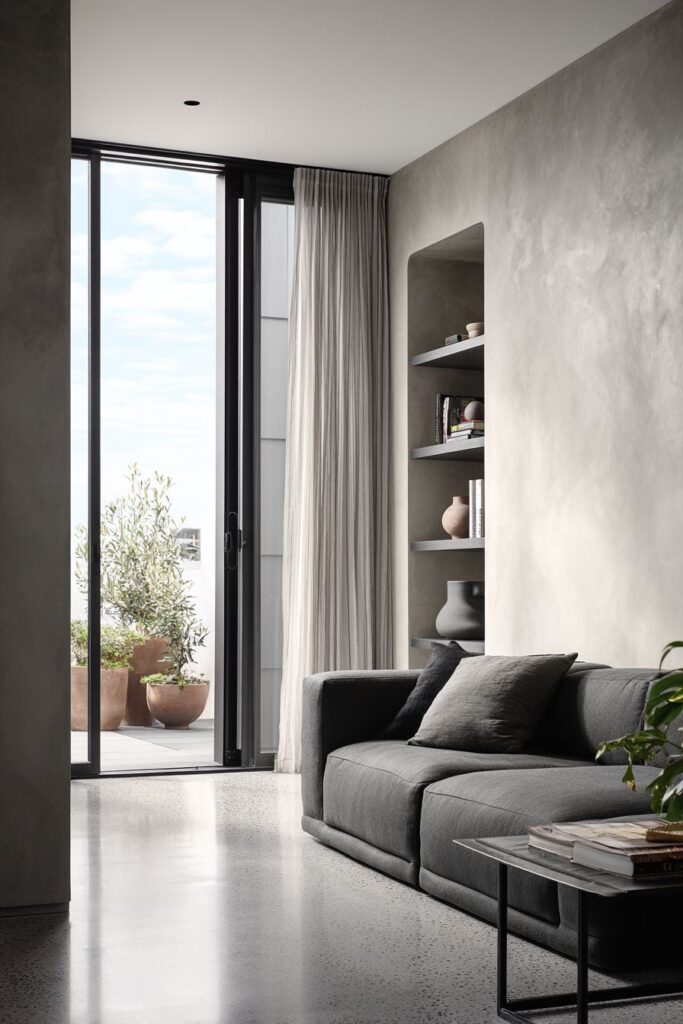
Key Design Tips:
- Use contrasting colors strategically to create visual impact
- Choose multifunctional furniture that serves multiple purposes
- Incorporate transparent materials like glass to maintain visual lightness
- Install built-in storage solutions to eliminate clutter
- Create strong indoor-outdoor connections through large windows or doors
3. Traditional Warmth: Timeless Comfort and Elegance
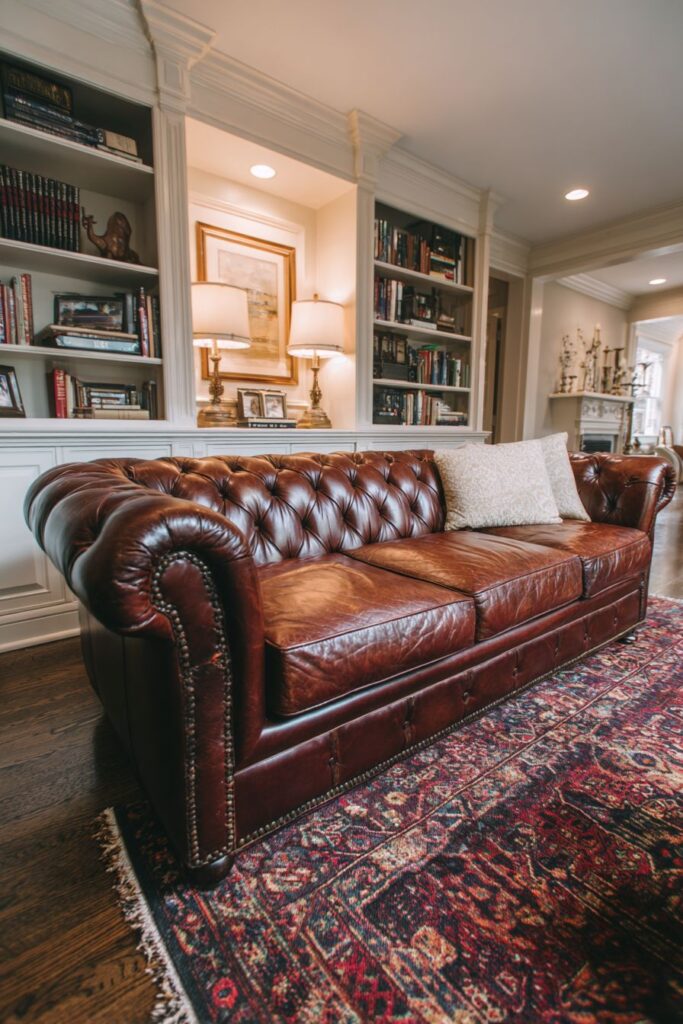
The traditional living room design embraces classic elements that have proven their enduring appeal over decades of changing trends. At its heart sits a comfortable brown leather Chesterfield sofa with brass nail head details – a piece that combines historical pedigree with modern comfort. The rich leather develops character over time, becoming more beautiful with age and use, embodying the traditional design philosophy that quality pieces are investments in long-term satisfaction.
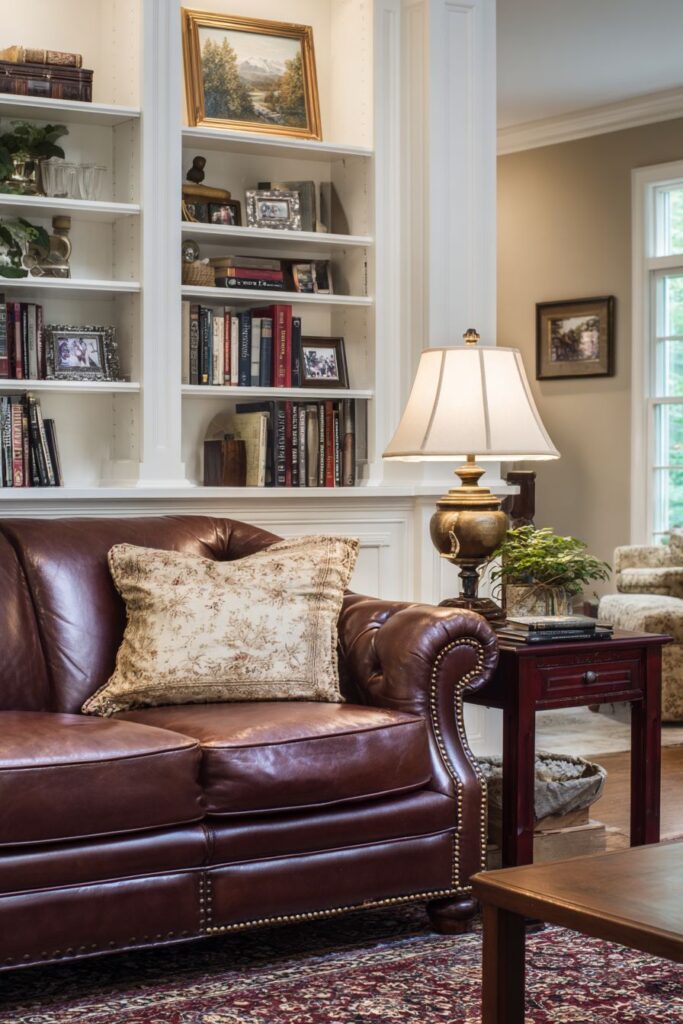
Rich cherry wood side tables flank the seating area, their warm tones harmonizing with the leather upholstery and creating a cohesive color story. These pieces rest upon a Persian-inspired area rug in deep burgundy and gold tones, adding pattern and warmth while anchoring the seating arrangement. Traditional rugs like these bring centuries of craftsmanship tradition into modern homes, connecting us to cultural heritage while providing practical comfort.
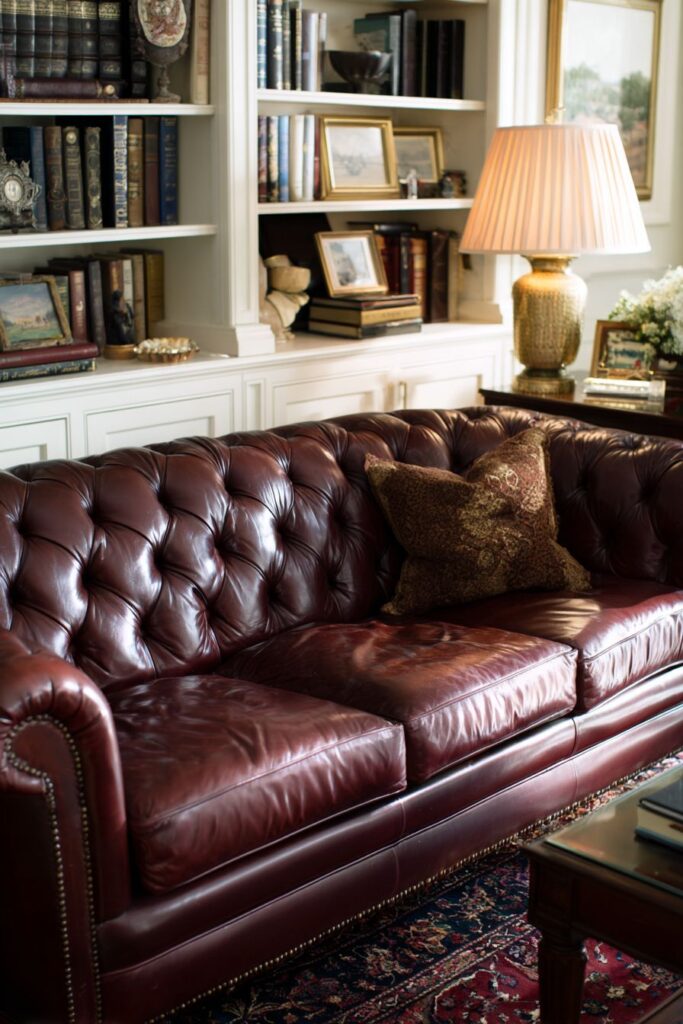
The built-in bookshelf wall represents one of traditional design’s greatest strengths: the integration of beauty and functionality. Painted white millwork provides a clean backdrop for books and family photos, creating a personalized gallery that tells the story of the home’s inhabitants. This approach to storage and display recognizes that our possessions can be both functional and decorative, contributing to the room’s personality and warmth.
Table lamps with cream fabric shades provide layered lighting that can be adjusted for different activities and moods. This approach to illumination recognizes that great lighting is never one-dimensional – it must serve practical needs while contributing to atmosphere. The warm light from these lamps enhances the rich textures and colors throughout the room, creating an inviting glow that makes guests feel immediately welcome.
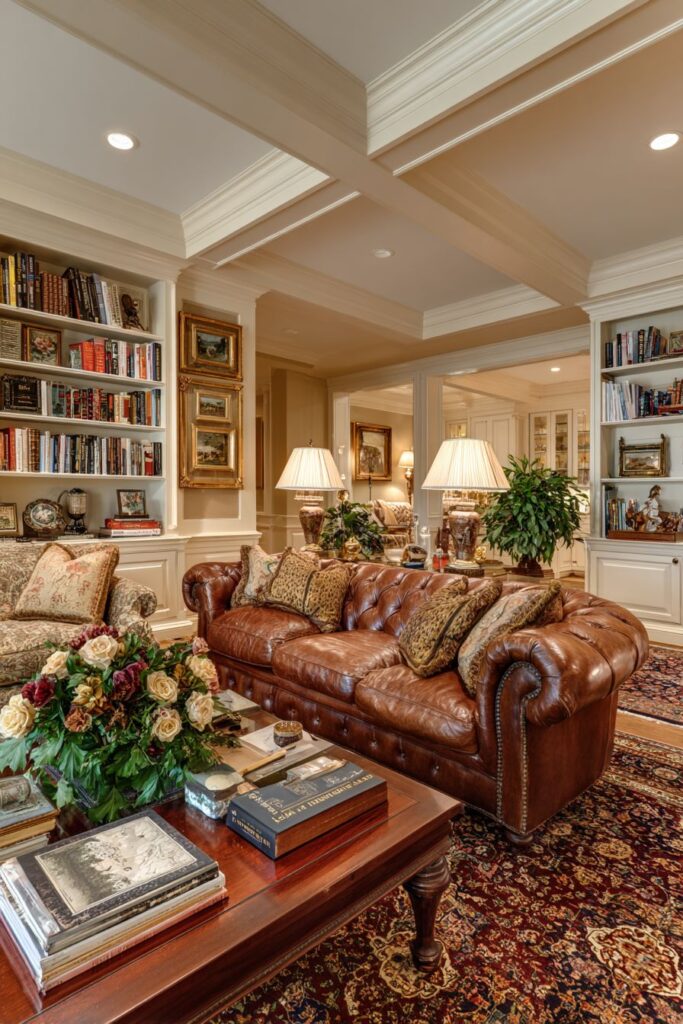
Key Design Tips:
- Invest in classic pieces like Chesterfield sofas that improve with age
- Layer warm colors and rich textures for depth and interest
- Incorporate built-in storage that serves both function and beauty
- Use multiple light sources to create adjustable ambiance
- Display books and personal items to add personality and warmth
4. Industrial Edge: Raw Materials and Urban Sophistication
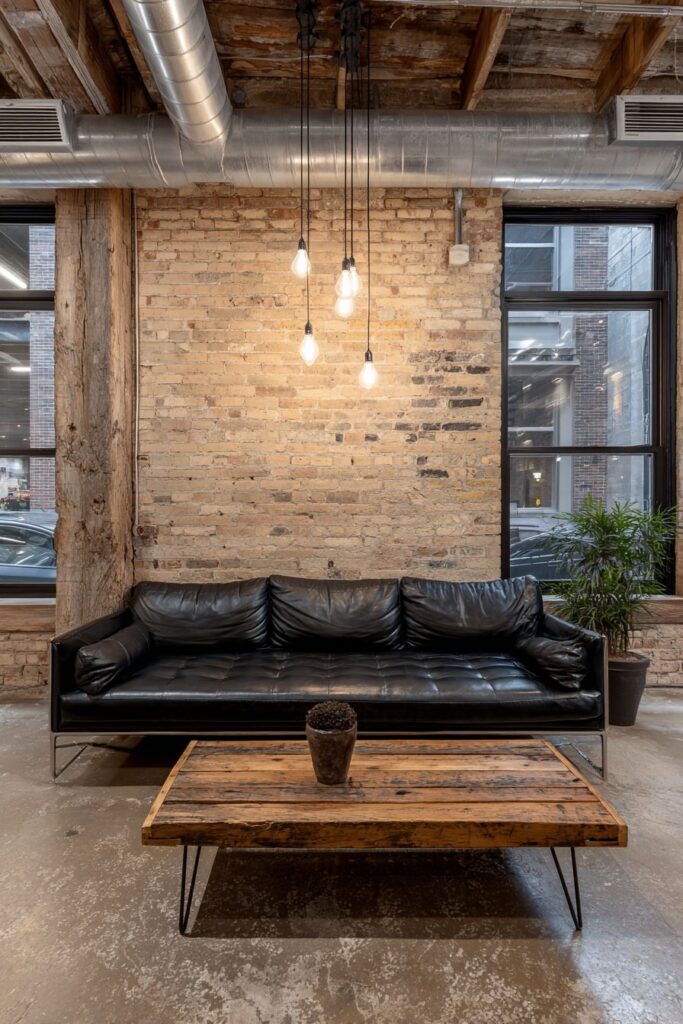
Industrial design celebrates the beauty of utilitarian materials and honest construction, creating living spaces that feel both urban and sophisticated. The black leather sofa with its metal frame makes no attempt to hide its structural elements, instead showcasing them as part of the design’s appeal. This transparency in construction reflects industrial design’s roots in factories and warehouses, where function dictated form and beauty emerged from necessity.

Exposed brick walls with visible mortar lines provide texture and history that manufactured materials can’t replicate. These walls tell stories of the building’s past while creating a dramatic backdrop for modern furnishing. The natural variations in brick color and the handcrafted quality of the mortar work add organic elements that soften the otherwise hard-edged aesthetic, proving that industrial design doesn’t have to feel cold or unwelcoming.
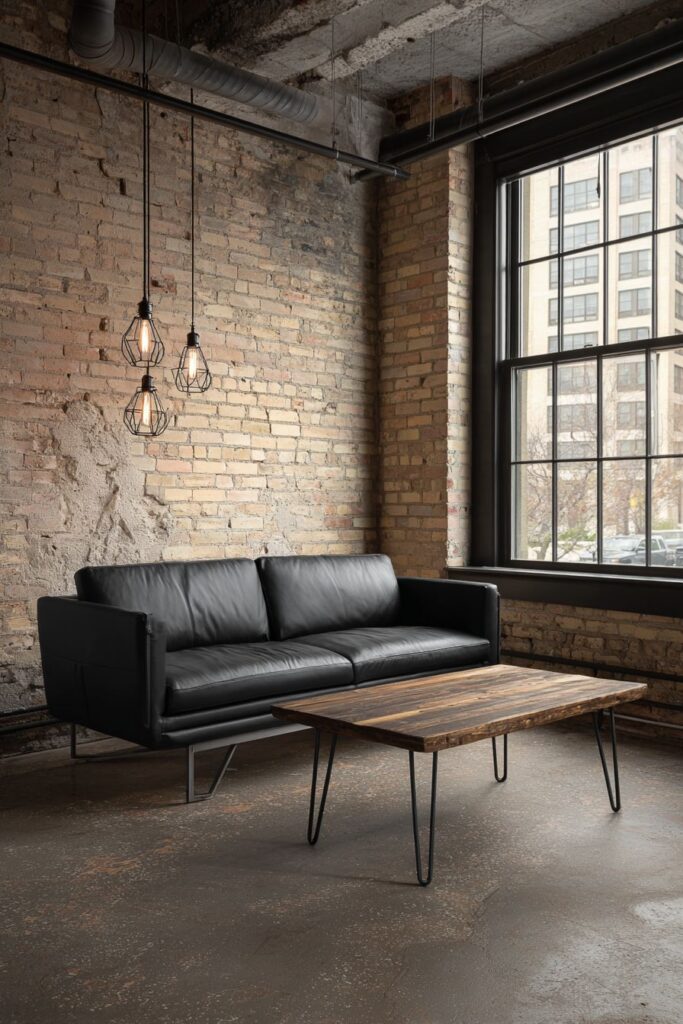
The reclaimed wood coffee table with steel hairpin legs perfectly embodies industrial design principles by combining salvaged materials with modern construction techniques. The wood’s previous life adds character and sustainability to the design, while the hairpin legs provide a light, airy support system that doesn’t compete with the wood’s natural beauty. This combination of old and new, heavy and light, creates visual tension that energizes the space.
Black metal pendant lights with Edison bulbs hung at varying heights create both task and ambient lighting while serving as sculptural elements. The exposed filaments in Edison bulbs celebrate the technology that powers them, turning functional elements into decorative features. The varying heights add visual rhythm and ensure even light distribution throughout the seating area, proving that industrial design can be both beautiful and practical.
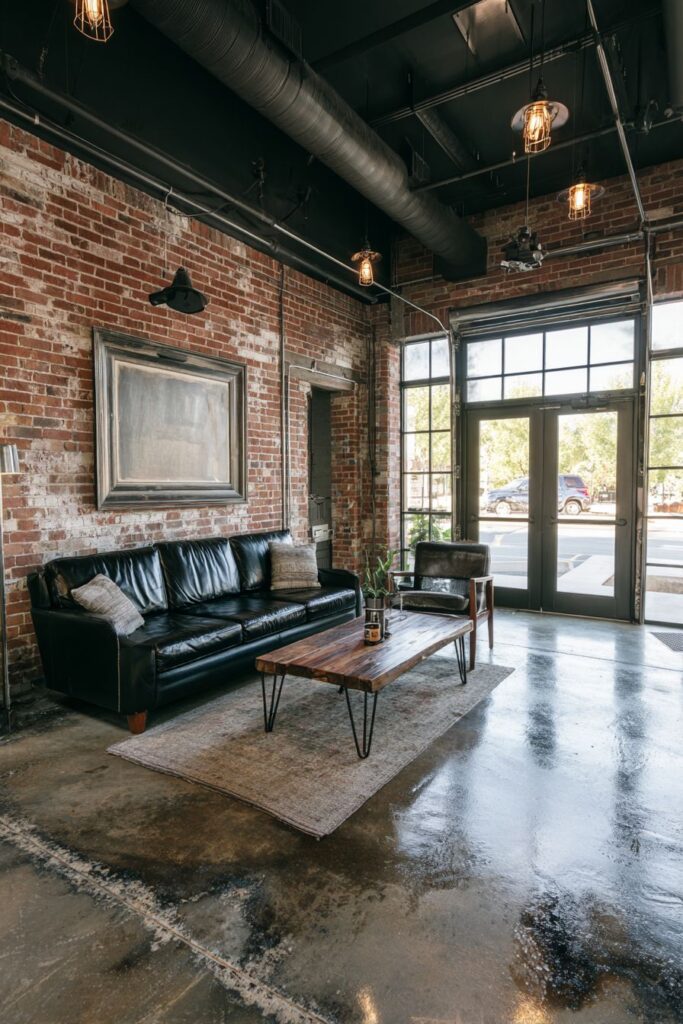
Key Design Tips:
- Embrace exposed structural elements like brick walls and metal frames
- Mix reclaimed materials with modern construction techniques
- Use pendant lighting at varying heights for visual interest and even illumination
- Choose furniture that celebrates rather than hides its construction
- Incorporate large windows with steel frames to maximize natural light
5. Mid-Century Modern Revival: Retro Sophistication for Today
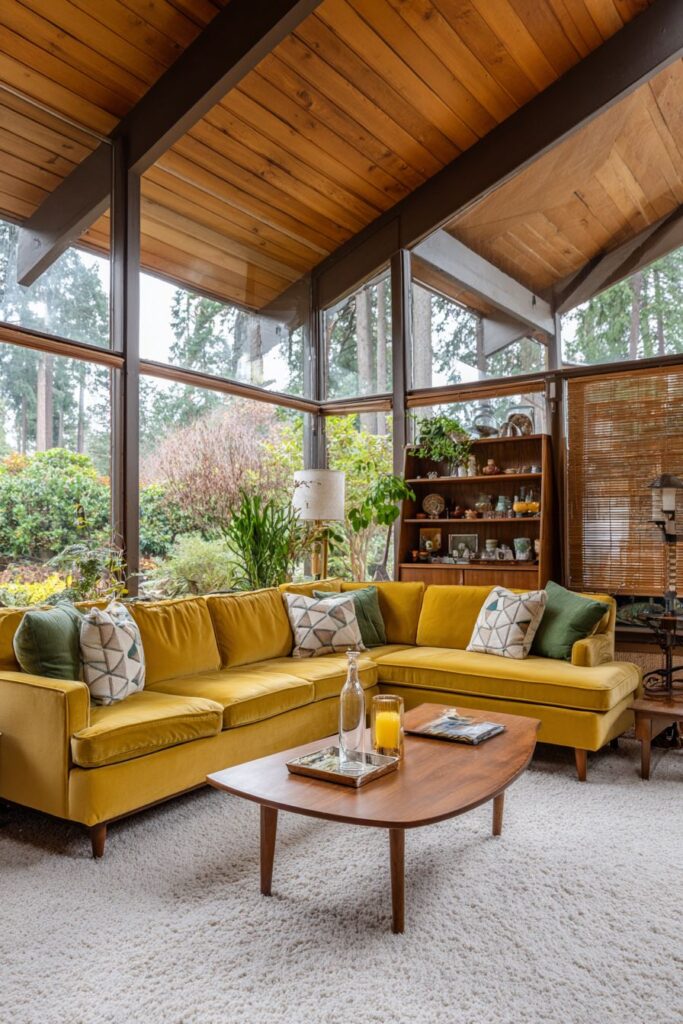
Mid-century modern design represents a golden age of American design when optimism about the future merged with appreciation for craftsmanship and natural materials. The mustard yellow velvet sofa with tapered walnut legs serves as a bold statement piece that captures the era’s confident use of color and innovative materials. The velvet upholstery adds luxury and comfort while the distinctive tapered legs became an iconic feature of 1950s and 1960s furniture design.

The kidney-shaped walnut coffee table represents mid-century designers’ willingness to experiment with organic forms inspired by nature. This departure from traditional rectangular shapes reflects the era’s interest in biomorphic design and the integration of natural forms into modern living. The original 1960s design credentials add authenticity and collectible value, making this piece both functional furniture and design artifact.
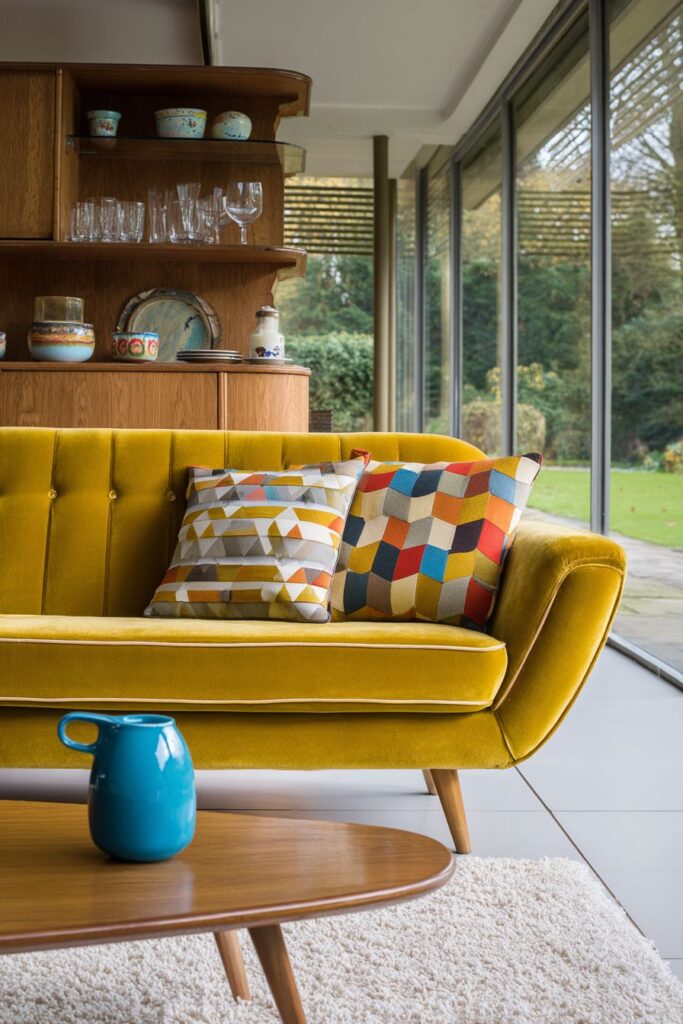
Built-in walnut shelving displays period-appropriate ceramics and glassware, creating a curated collection that supports the room’s overall aesthetic. These display pieces aren’t just decorative – they represent the mid-century belief that well-designed objects should be part of daily life rather than hidden away. The warm walnut wood creates continuity throughout the room while providing rich contrast to the velvet upholstery.
Large picture windows with horizontal wood blinds exemplify mid-century architecture’s emphasis on bringing the outdoors in. The horizontal lines of the blinds echo the era’s preference for long, low furniture and architectural details that emphasized width rather than height. This window treatment allows for precise light control while maintaining the clean lines that define mid-century style.
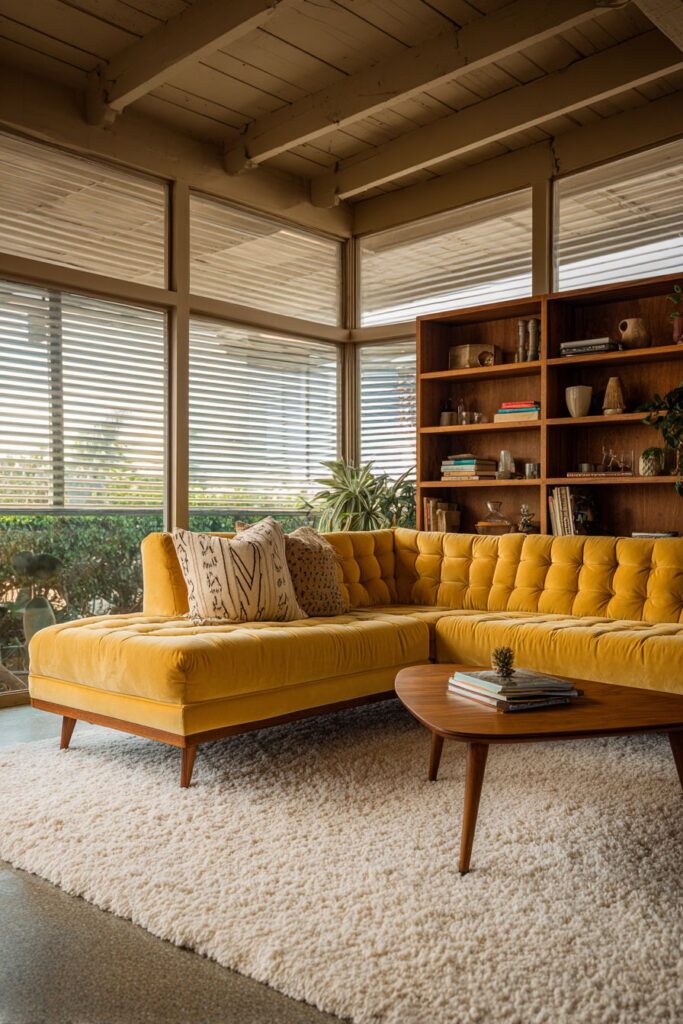
Key Design Tips:
- Choose furniture with distinctive period details like tapered legs and organic shapes
- Incorporate bold colors through upholstery and accessories
- Display period-appropriate ceramics and glassware as functional art
- Use horizontal elements to emphasize width and create visual calm
- Invest in authentic vintage pieces when possible for maximum impact
6. Small Space Solutions: Maximizing Style in Minimal Square Footage
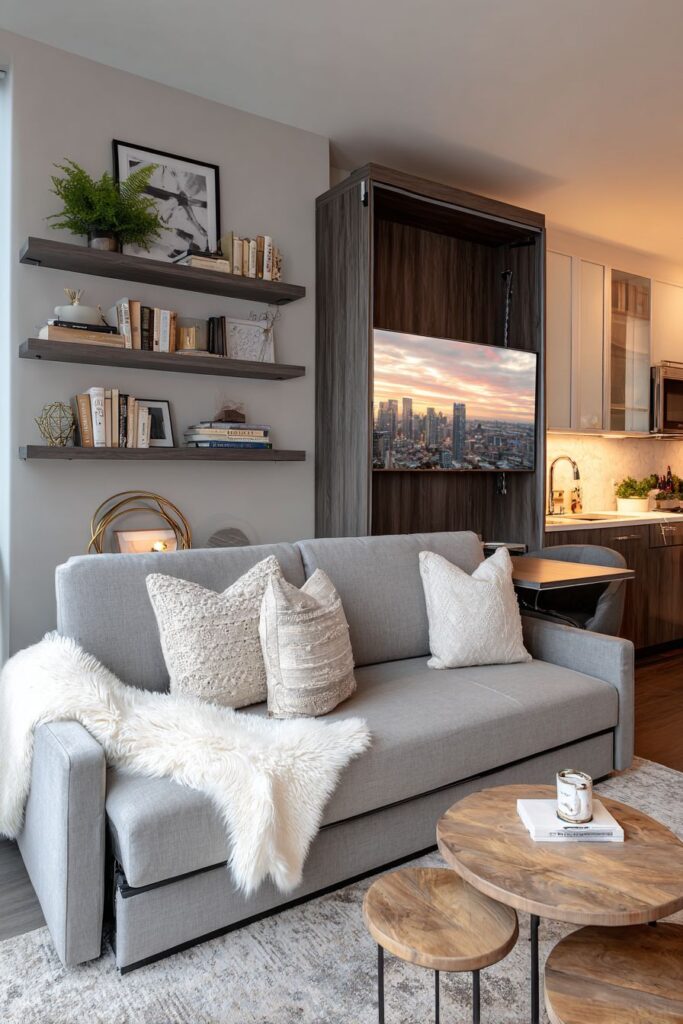
Small space living requires creative thinking and strategic design choices that maximize both function and style without creating a cramped or cluttered feeling. The light grey loveseat with hidden storage underneath demonstrates how modern furniture can serve multiple purposes while maintaining elegant proportions. This dual-function approach is essential in small spaces where every piece must justify its presence through both beauty and utility.
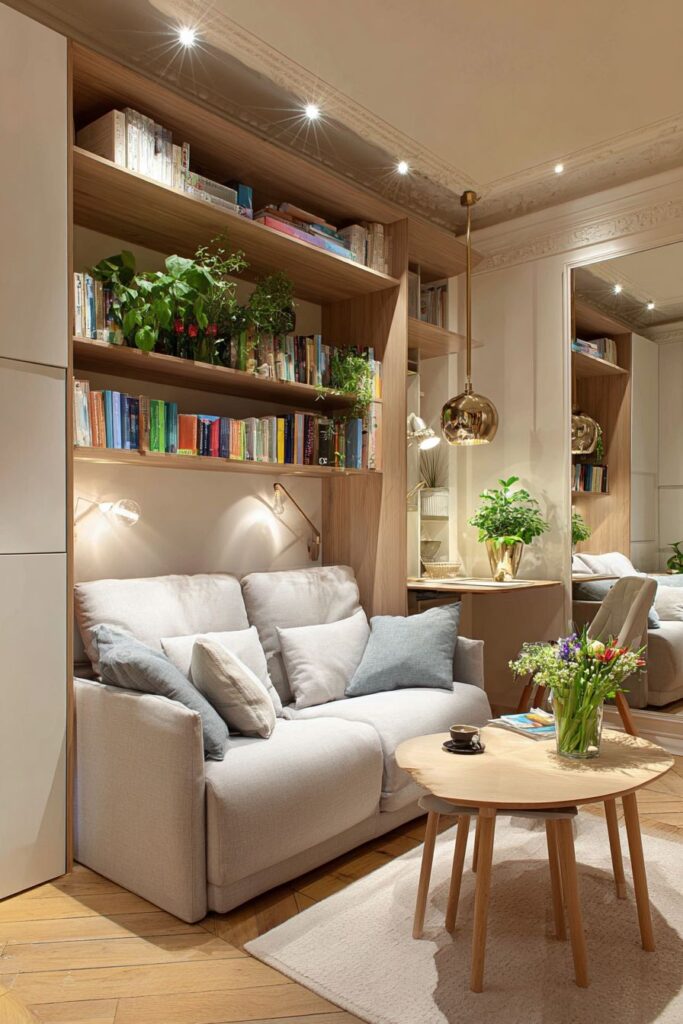
The round nesting coffee table set in natural oak provides flexible surface space that can be adapted to different needs and occasions. When separated, the tables can serve different areas of the room or provide additional surface space for entertaining. When nested, they minimize their footprint while maintaining the option for expansion – a perfect example of furniture that grows and shrinks with daily needs.
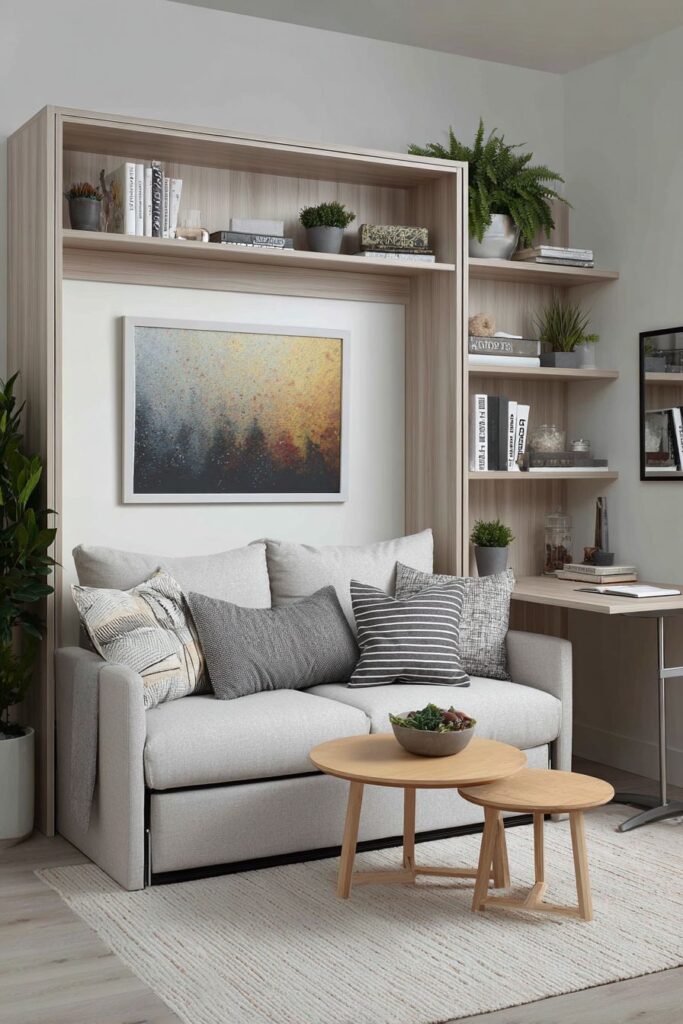
Wall-mounted floating shelves offer storage and display opportunities without consuming valuable floor space. The vertical storage approach draws the eye upward, creating an illusion of greater height while providing practical storage for books and plants. The incorporation of greenery through plants adds life and color while improving air quality – important considerations in smaller spaces where every element has greater impact.
The fold-down desk provides occasional workspace without permanently dedicating floor area to office functions. This flexible approach to space planning recognizes that modern living often requires multiple functions from single rooms. Strategic mirror placement multiplies natural light and creates the illusion of greater space, a time-tested technique that works especially well in small rooms with limited natural light sources.
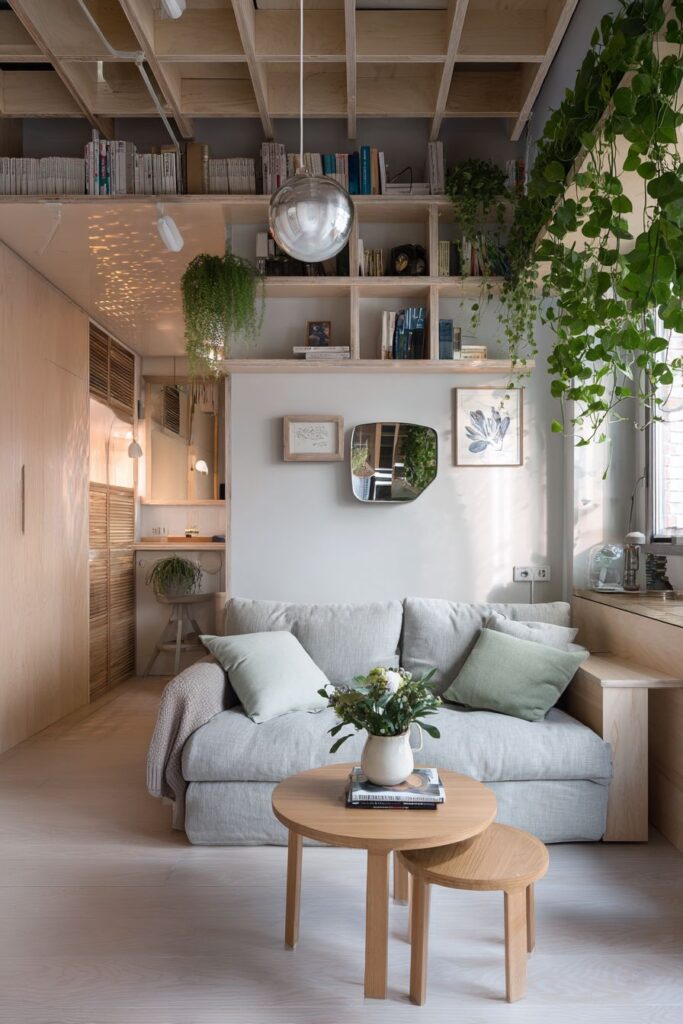
Key Design Tips:
- Choose furniture with hidden storage to maximize utility
- Use nesting or modular pieces that can adapt to different needs
- Mount storage vertically to preserve floor space
- Incorporate mirrors strategically to multiply light and create spatial illusions
- Choose light colors to enhance the sense of spaciousness
7. Bohemian Eclecticism: Global Influences and Layered Textures
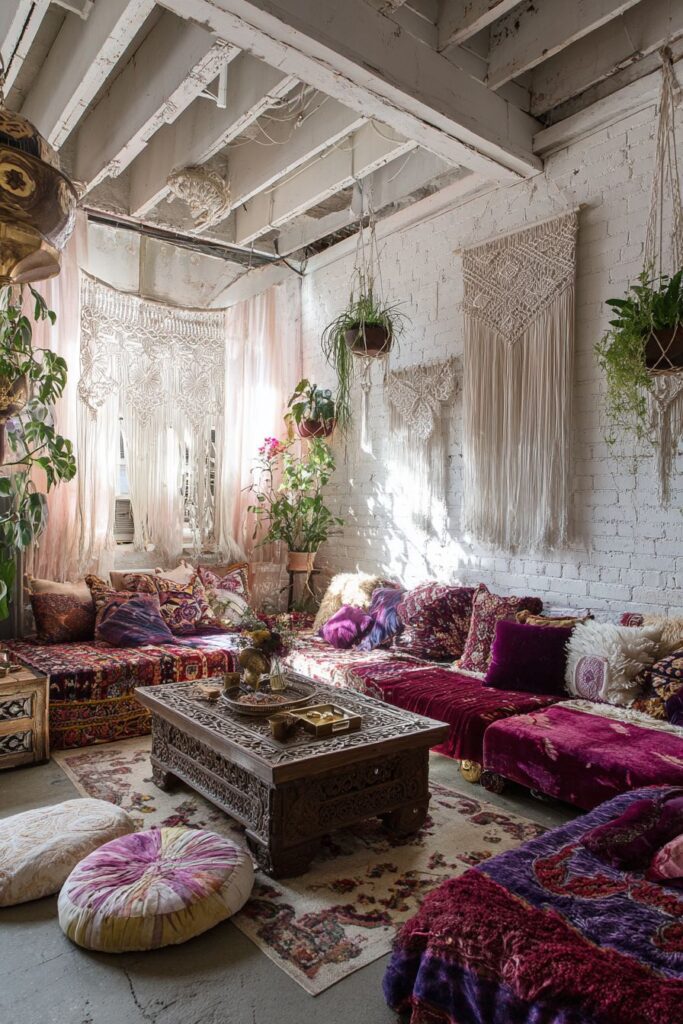
Bohemian design celebrates individuality, creativity, and cultural exchange through an eclectic mix of patterns, textures, and artifacts from around the world. The low-profile sectional sofa with jewel-toned velvet cushions provides a luxurious foundation for the room’s layered aesthetic. The abundance of patterned throw pillows creates visual richness while allowing for seasonal changes and personal expression through color and design choices.

The vintage Moroccan rug in rich burgundy and gold anchors the seating area while introducing traditional craftsmanship and cultural heritage into the modern space. These handwoven rugs bring centuries of artistic tradition and symbolic meaning, connecting the room’s inhabitants to global culture while providing warmth and texture underfoot. The intricate patterns and rich colors serve as artwork for the floor, justifying their prominent placement in the room’s design.
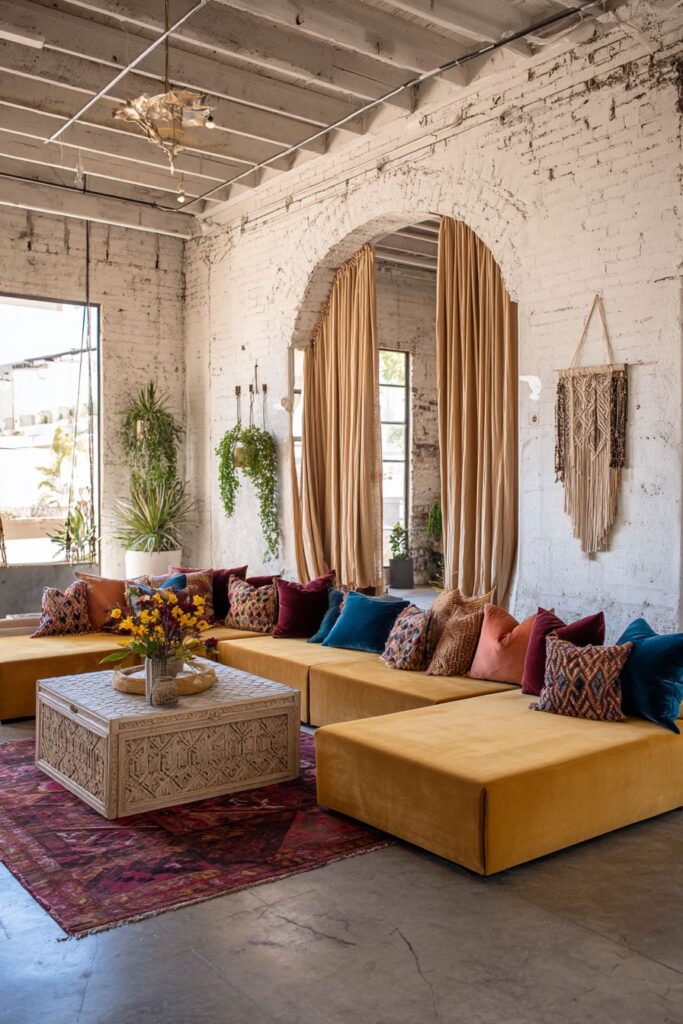
Macramé wall hangings and trailing plants create vertical interest while introducing natural elements that soften the space’s edges. The handcrafted quality of macramé work adds artisanal appeal and textural variety to the walls, while trailing plants bring life and movement to otherwise static surfaces. This combination of crafted and natural elements reflects bohemian design’s appreciation for both human creativity and natural beauty.
The carved wooden coffee table with intricate details serves as both functional surface and sculptural centerpiece. Its handcrafted quality and detailed workmanship represent the bohemian appreciation for artisanal skills and unique objects that tell stories. The natural light filtering through flowing curtains in earthy tones creates a dreamy, romantic atmosphere that invites relaxation and contemplation.

Key Design Tips:
- Layer multiple patterns and textures for visual richness
- Incorporate handcrafted elements like macramé and carved wood
- Use vintage rugs as both functional and decorative anchors
- Add trailing plants for natural movement and vertical interest
- Choose flowing window treatments that create soft, filtered light
8. Farmhouse Charm: Rustic Elegance with Modern Comfort
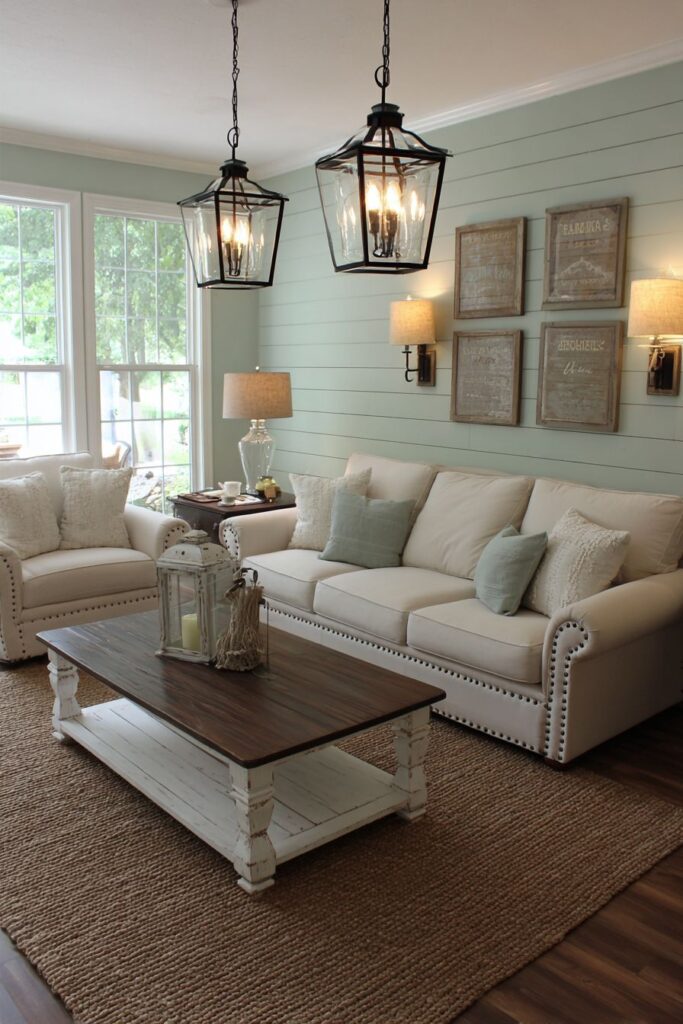
Farmhouse design combines the comfort and practicality of rural living with refined aesthetic choices that create sophisticated yet approachable spaces. The cream linen sectional sofa with rolled arms and nail head trim exemplifies this balance between casual comfort and polished detail. The linen fabric ages beautifully and improves with use, while the traditional rolled arms and nail head trim add classic details that elevate the piece beyond basic casual furniture.
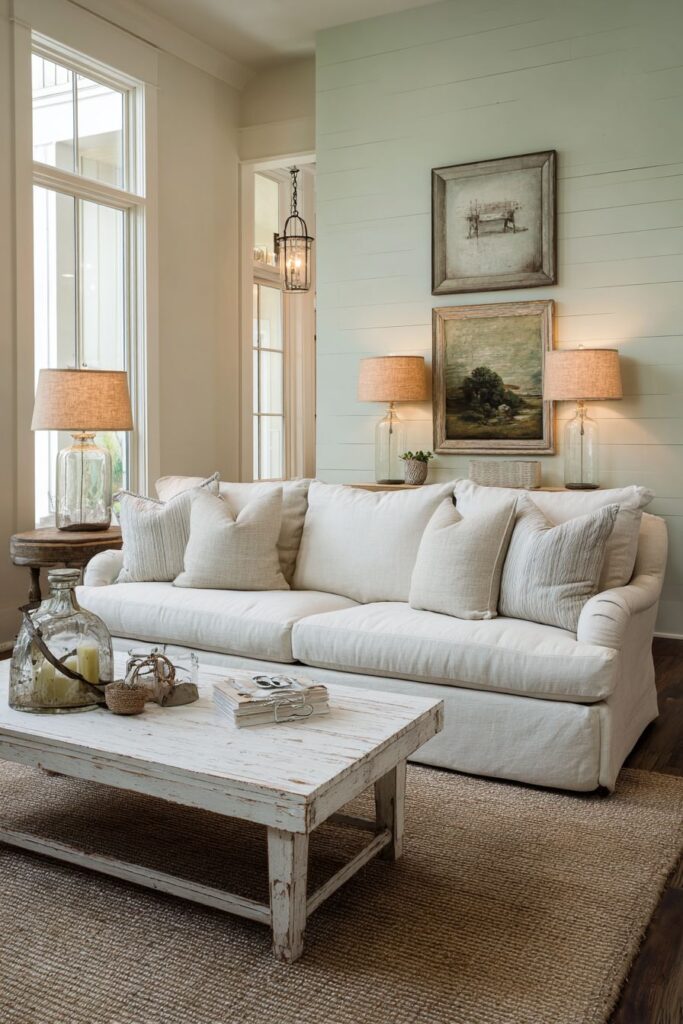
The distressed white wooden coffee table with planked top brings authentic farmhouse character through its weathered finish and traditional construction techniques. This piece demonstrates how farmhouse style celebrates the beauty of aging and use, finding character in imperfection and history in wear patterns. The planked construction references traditional building methods while providing a substantial surface for daily use.
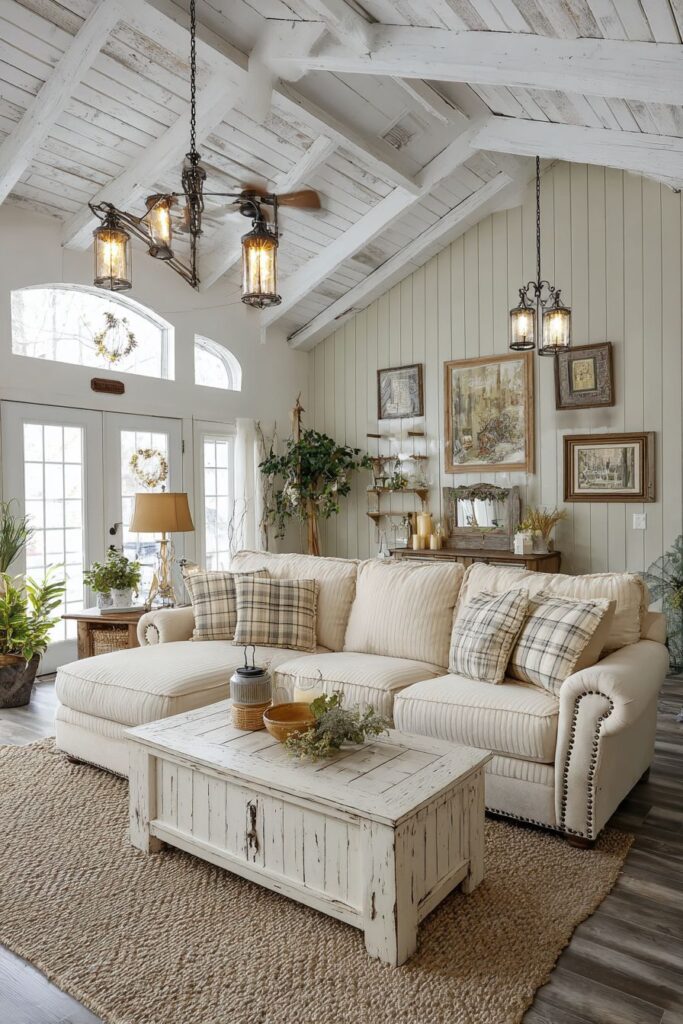
The shiplap accent wall painted in soft sage green provides textural interest while introducing color in a subtle, sophisticated way. Shiplap construction techniques originated in rural building practices but have been refined for modern interiors, creating walls with subtle shadow lines and authentic texture. The sage green color connects the interior to natural landscapes while providing a calming backdrop for vintage-inspired artwork.
Mason jar pendant lights and table lamps with burlap shades create layered lighting with authentic farmhouse materials. These fixtures reference traditional rural lighting solutions while providing modern functionality and appropriate light levels. The combination of pendant and table lamps ensures adequate illumination for different activities while maintaining the room’s warm, inviting atmosphere.
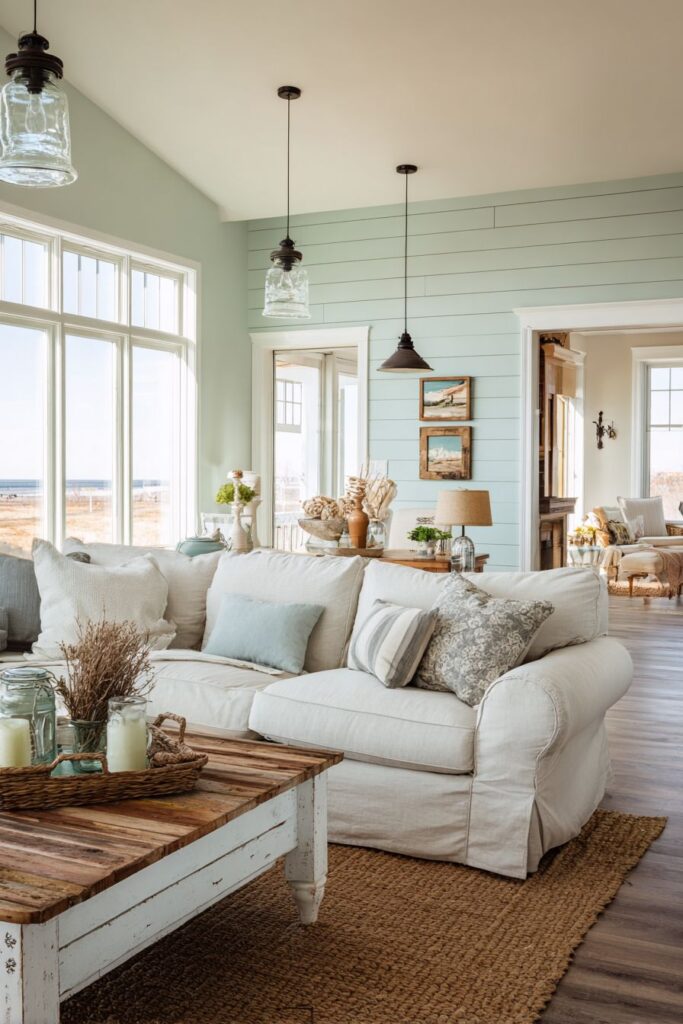
Key Design Tips:
- Choose natural fabrics like linen that improve with age and use
- Incorporate distressed finishes for authentic farmhouse character
- Use shiplap or other traditional wall treatments for texture
- Select lighting fixtures made from traditional materials like mason jars
- Paint accent walls in soft, nature-inspired colors
9. Contemporary Drama: Bold Colors and Geometric Forms
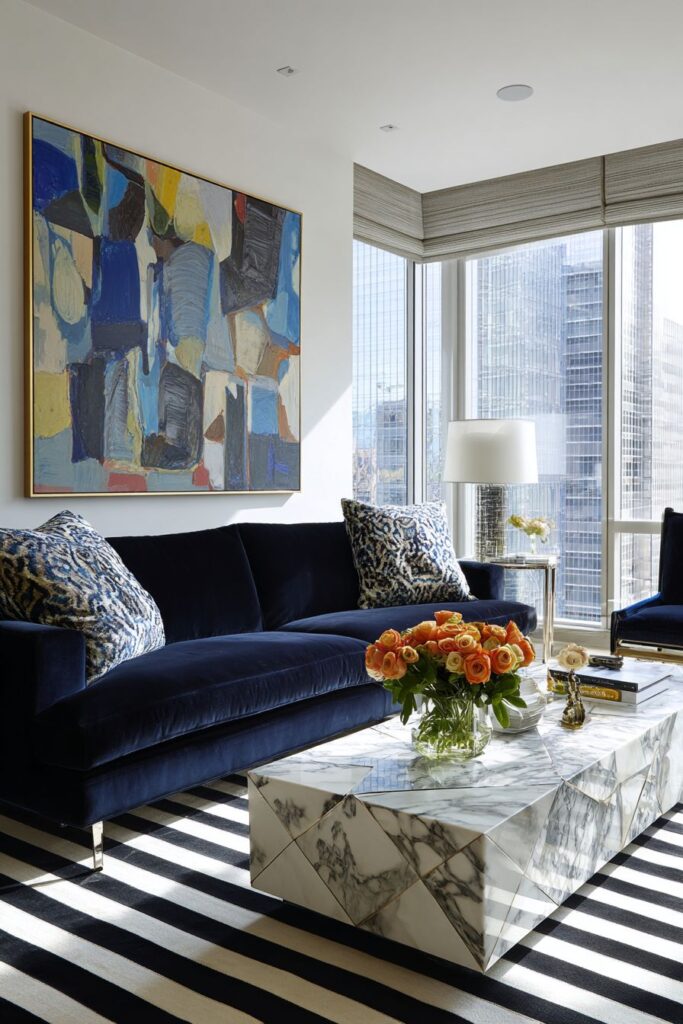
Contemporary design embraces current trends while maintaining timeless principles of good proportion and thoughtful material selection. The bold navy blue velvet sofa with chrome legs creates a dramatic focal point that anchors the room’s sophisticated color scheme. The deep blue provides richness and depth while the chrome legs add modern sophistication and light-reflecting surfaces that keep the piece from feeling heavy or overwhelming.
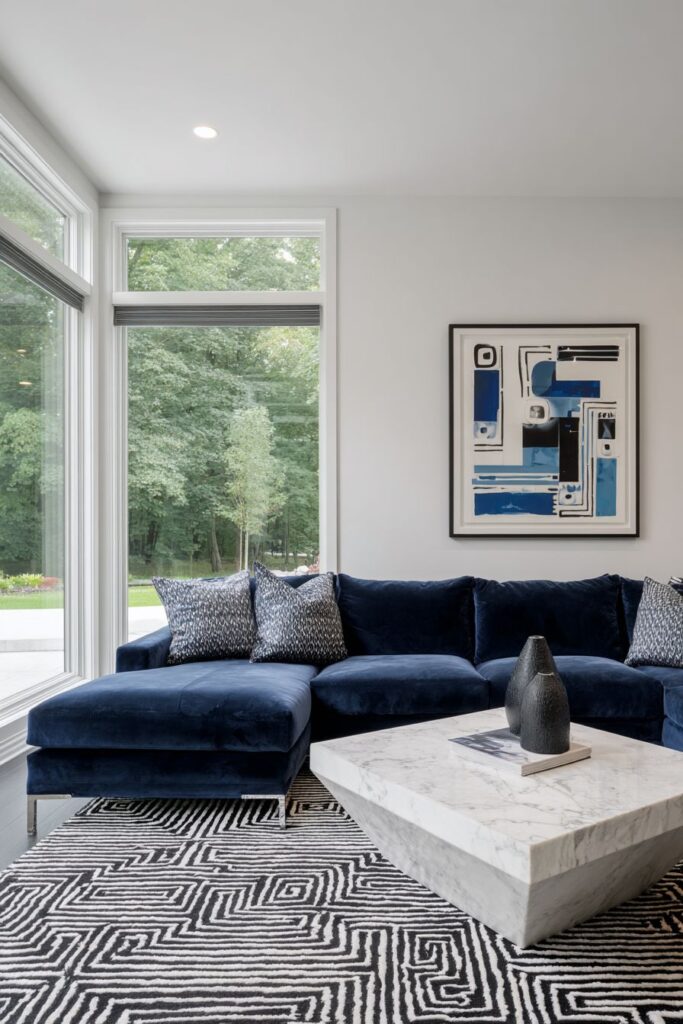
The marble-top coffee table with geometric base design represents contemporary design’s appreciation for both natural materials and modern forms. The marble surface provides luxury and durability while the geometric base adds sculptural interest and architectural detail. This combination of organic stone and geometric metal creates visual tension that energizes the space without creating discord.
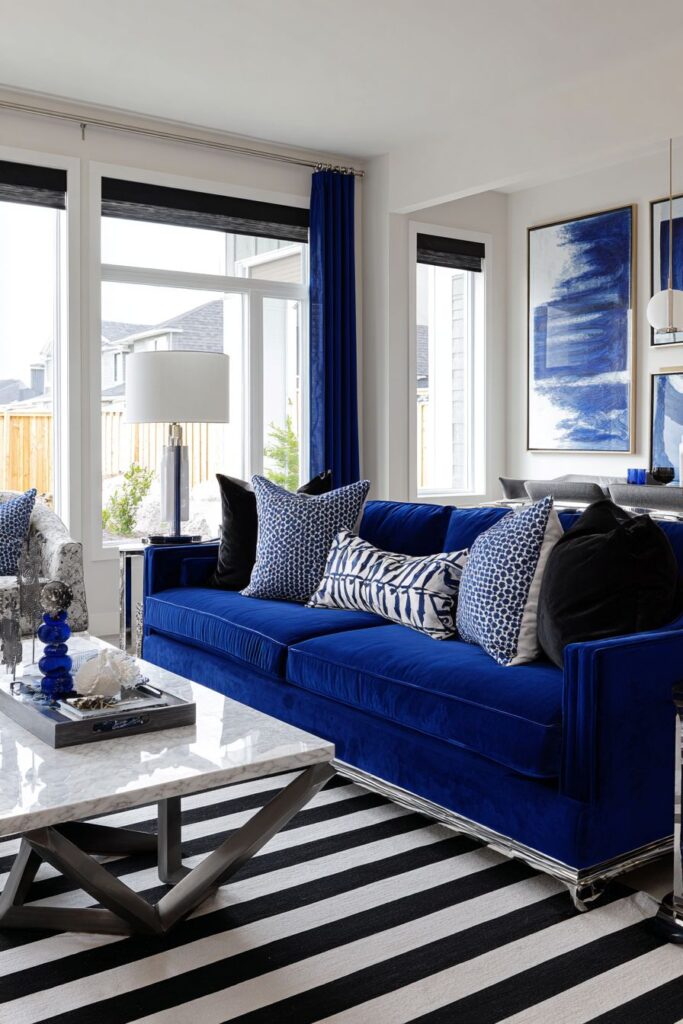
The black and white striped area rug provides bold graphic impact while grounding the seating arrangement and defining the living area within the larger space. Stripes create visual movement and can be used to manipulate spatial perception – horizontal stripes widen spaces while vertical stripes add height. The high contrast pattern complements the room’s dramatic color scheme while providing neutral grounding for the vibrant upholstery.
Abstract artwork in complementary colors creates visual impact above the seating area while reflecting the room’s sophisticated aesthetic. Contemporary art allows for personal expression while contributing to the overall design scheme through color, scale, and composition. Floor-to-ceiling windows with motorized blinds provide precise light control while maintaining the clean lines essential to contemporary design.
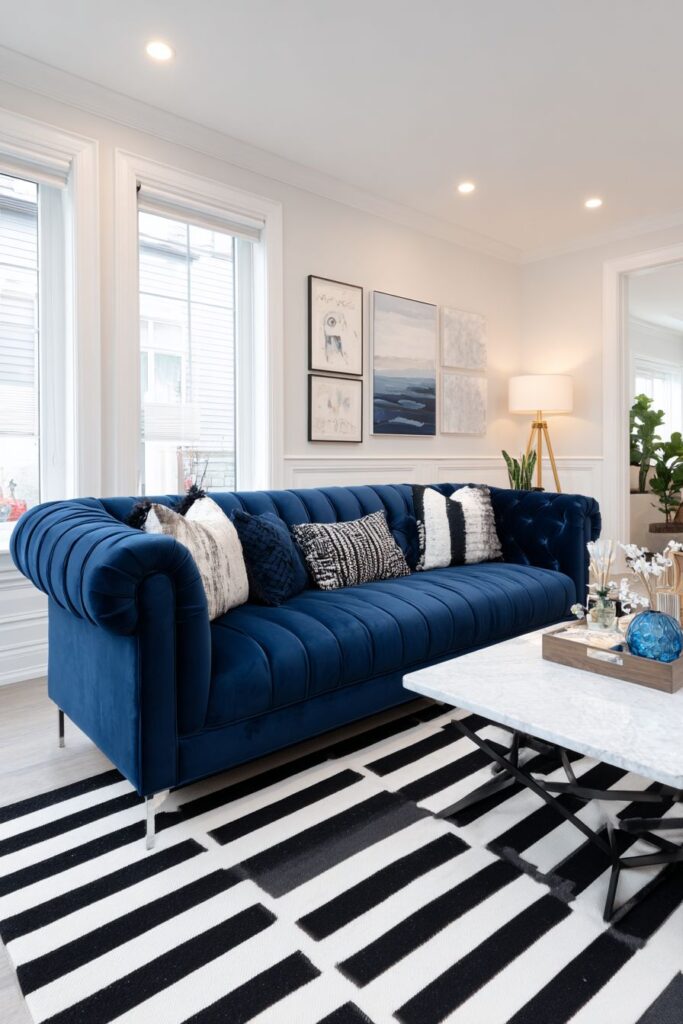
Key Design Tips:
- Use bold colors strategically to create focal points
- Combine natural materials like marble with geometric forms
- Incorporate high-contrast patterns for visual drama
- Choose abstract art that complements your color scheme
- Install motorized window treatments for both function and sophistication
10. Neutral Sophistication: Tonal Harmony and Natural Textures

Neutral palette design demonstrates that sophistication doesn’t require bold colors or dramatic contrasts – sometimes the most refined spaces are those that celebrate subtle variations within a limited color range. The beige linen sectional sofa with deep seating provides exceptional comfort while its natural fabric and generous proportions create an inviting foundation for relaxation. The varying textures of linen blend throw pillows add tactile interest while maintaining color cohesion.
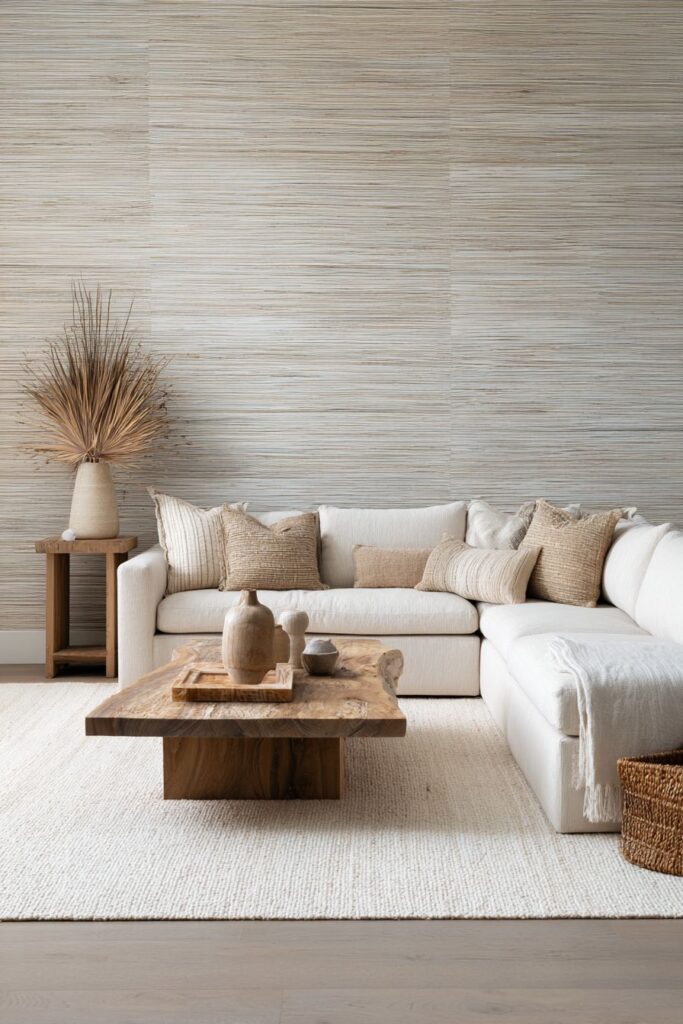
The natural live-edge wood coffee table celebrates the organic beauty of unprocessed materials, bringing the outdoors inside through its natural form and grain patterns. Live-edge pieces showcase the tree’s natural growth patterns and irregularities, creating one-of-a-kind furniture that connects inhabitants to nature’s processes. The substantial presence of this piece grounds the light-colored seating while adding warmth and character to the neutral scheme.

Woven grass cloth wallpaper adds organic texture to the accent wall without introducing competing colors or patterns. This natural material provides subtle variation in texture and light reflection while maintaining the room’s serene atmosphere. The handwoven quality adds artisanal appeal and connects the interior to traditional crafting techniques that celebrate natural materials.
Natural rattan accessories and ceramic pottery in earth tones complete the composition by introducing additional natural textures and subtle color variations. These elements work together to create a layered, sophisticated look that feels both curated and organic. The cohesive neutral scheme allows the focus to remain on texture, form, and the quality of natural light throughout the space.

Key Design Tips:
- Layer different textures within a single color family for depth
- Choose live-edge furniture to bring natural irregularity into refined spaces
- Use natural wallcoverings like grass cloth for subtle texture
- Incorporate handcrafted accessories in complementary earth tones
- Focus on material quality and natural light when color is minimal
11. Built-In Beauty: Custom Storage Solutions for Modern Living

Built-in storage solutions represent the ultimate marriage of form and function, creating custom millwork that serves practical needs while contributing to the room’s architectural character. The painted white millwork with adjustable shelving and hidden cabinet doors provides flexible storage that can adapt to changing needs over time. The clean white finish integrates seamlessly with the room’s architecture while the adjustable shelving accommodates items of various sizes.

The grey fabric sofa with clean lines is positioned to take advantage of the storage wall’s functionality while maintaining comfortable proportions for daily use. This strategic placement creates a cohesive relationship between seating and storage, ensuring that frequently used items remain within easy reach. The sofa’s neutral color allows the built-in millwork to serve as the room’s primary architectural feature.

Integrated LED lighting strips within the built-ins provide both task lighting for finding items and accent lighting that highlights displayed objects. This integrated approach to illumination eliminates the need for additional table lamps while creating even, shadow-free lighting throughout the storage areas. The LED technology provides energy efficiency and long life while offering precise control over light levels and color temperature.
Natural oak flooring with visible grain patterns grounds the space with organic warmth while providing durability for high-traffic areas. The wood’s natural variation adds visual interest to the floor plane while complementing the room’s neutral color scheme. The visible grain patterns celebrate the material’s natural beauty while providing a foundation that ages gracefully over time.
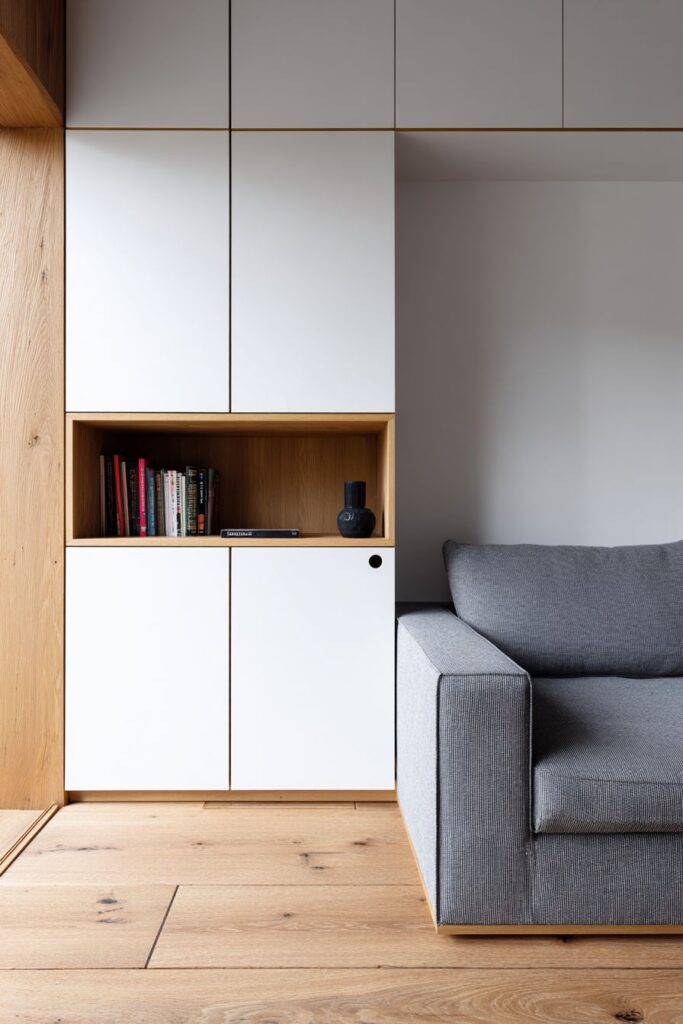
Key Design Tips:
- Design built-ins with adjustable components for long-term flexibility
- Integrate lighting within storage areas for both function and aesthetics
- Choose neutral colors for built-ins to ensure they age well with changing decor
- Position seating to take advantage of storage accessibility
- Use natural wood flooring to ground neutral color schemes with organic warmth
12. Open Concept Flow: Seamless Living for Modern Families
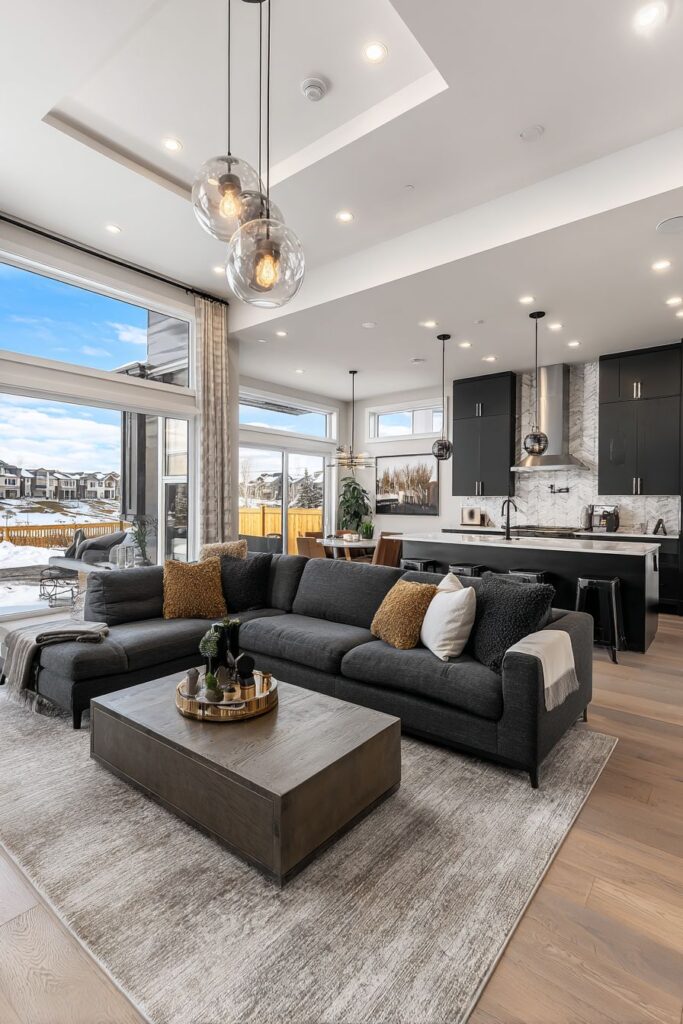
Open concept living recognizes that modern families need flexible spaces that can adapt to multiple activities while maintaining visual and physical connection between different functional areas. The large sectional sofa in charcoal grey defines the living space without creating barriers that would interrupt sight lines to adjacent areas. The substantial size provides ample seating for family gatherings while the neutral color ensures it works with various decorating schemes over time.

Consistent wide-plank white oak flooring throughout all areas creates visual continuity that makes the entire space feel larger and more cohesive. This unified flooring approach eliminates transition strips and visual breaks that can fragment open spaces, instead creating a seamless foundation that allows furniture and area rugs to define individual zones. The white oak provides durability for high-traffic areas while aging beautifully with use and natural light exposure.
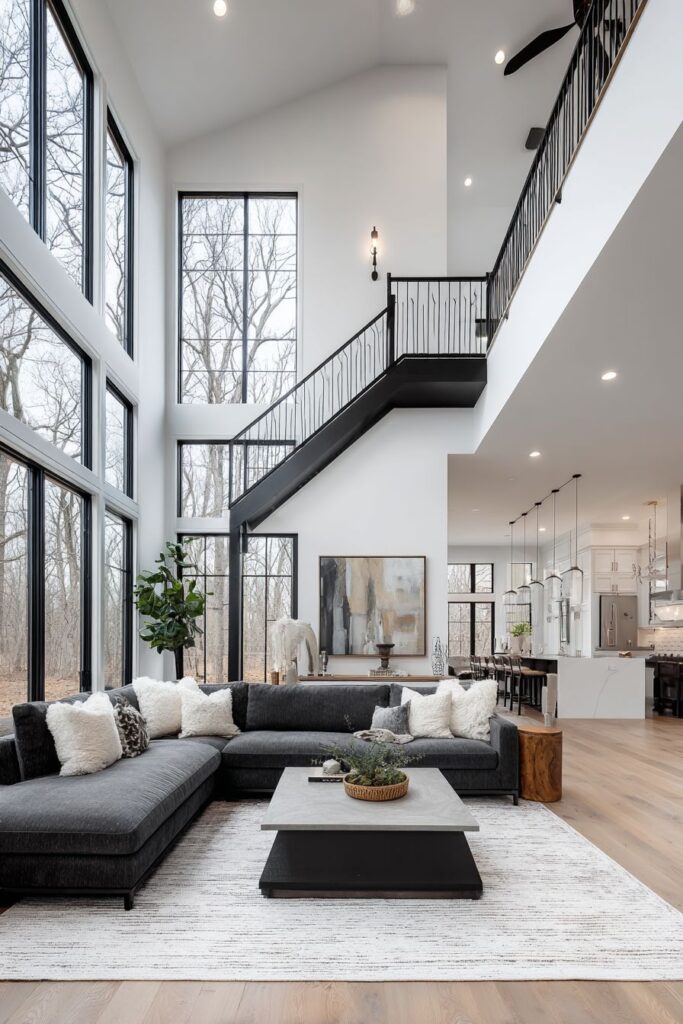
The substantial rectangular coffee table anchors the seating arrangement while providing generous surface space for family activities and entertaining. Its placement on a large area rug helps define the living zone within the larger open space, creating psychological boundaries without physical barriers. The rug’s size and placement are crucial in open concept spaces, as they must be large enough to anchor furniture while defining distinct functional areas.
Abundant natural light from multiple windows creates a bright, airy atmosphere that enhances the sense of spaciousness inherent in open concept design. Multiple light sources ensure even illumination throughout the day while reducing the harsh shadows that can fragment open spaces. The strategic placement of windows also provides natural ventilation and views to outdoor spaces, further expanding the sense of space and connection to nature.

Key Design Tips:
- Use consistent flooring throughout to create visual continuity
- Choose substantial furniture pieces that can anchor large spaces
- Define zones with appropriately sized area rugs
- Maximize natural light from multiple sources for even illumination
- Maintain clear sight lines between functional areas
13. Fireplace Focus: The Hearth as Living Room Centerpiece

The fireplace has served as the heart of the home for centuries, and contemporary design continues to celebrate this primal gathering place through sophisticated material choices and thoughtful integration with modern furniture. The limestone fireplace with natural stone texture provides both visual and physical warmth, creating a focal point that draws people together for conversation and relaxation. The natural variations in limestone create unique patterns and colors that connect the interior to geological processes and natural beauty.

The built-in wood storage niche serves both practical and aesthetic functions, keeping fuel readily available while creating architectural interest through its geometric form. This integration of storage into the fireplace design eliminates the need for separate wood storage while contributing to the room’s organized, intentional appearance. The niche’s proportions and placement are carefully considered to complement the fireplace’s overall composition.

The comfortable sectional sofa in warm grey faces the hearth to optimize both fire viewing and conversation, recognizing that successful living rooms must serve multiple social functions. The positioning creates an intimate conversation area while ensuring all seats have good views of the fire. The warm grey color harmonizes with the limestone while providing neutral background for seasonal decorating and textile changes.
The rustic wooden coffee table bridges the gap between the sofa and fireplace, providing surface space for beverages and books while maintaining easy access to the hearth. Its placement is carefully calculated to allow comfortable conversation distances while keeping the fire visible and accessible for tending. The mantel displays pottery and natural elements that complement the limestone texture while adding personal touches that make the space feel inhabited rather than merely decorated.
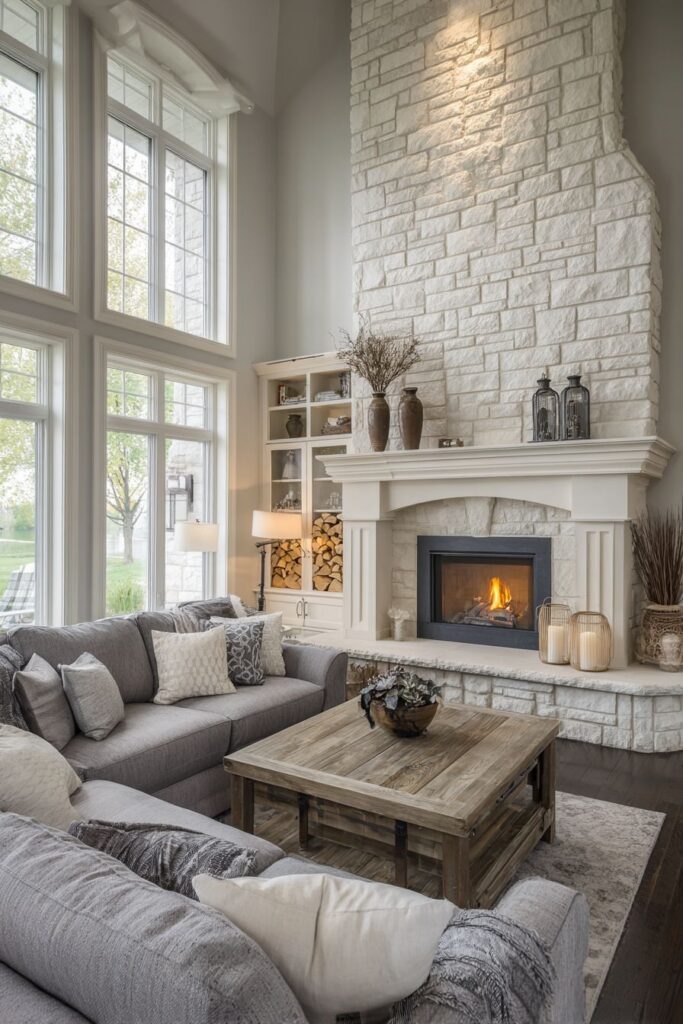
Key Design Tips:
- Choose natural stone for fireplace surrounds to add texture and visual weight
- Integrate wood storage into the fireplace design for both function and aesthetics
- Position seating to optimize both fire viewing and conversation
- Use the mantel for displaying carefully chosen objects that complement the stone texture
- Layer lighting to work with firelight for cozy evening ambiance
14. Rustic Authenticity: Celebrating Natural Materials and Honest Construction
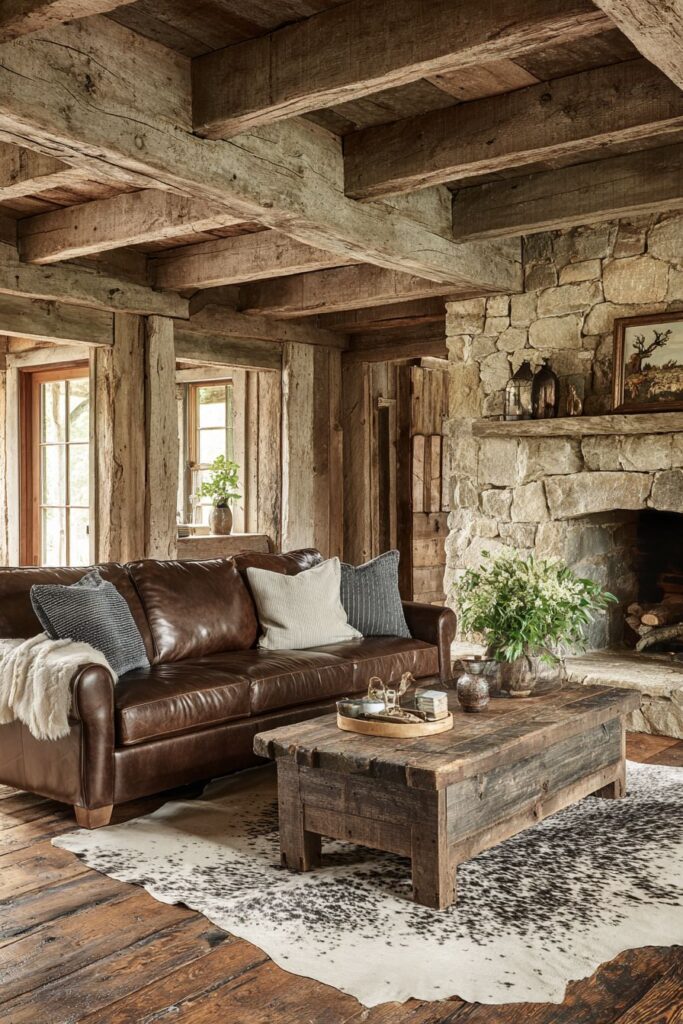
Rustic design celebrates the beauty found in natural materials, traditional construction methods, and the patina that comes with age and use. The brown leather sofa with natural aging and patina represents furniture that improves over time, developing character marks that tell the story of daily life. This approach to materials values authenticity over perfection, finding beauty in the honest wear patterns that synthetic materials cannot replicate.
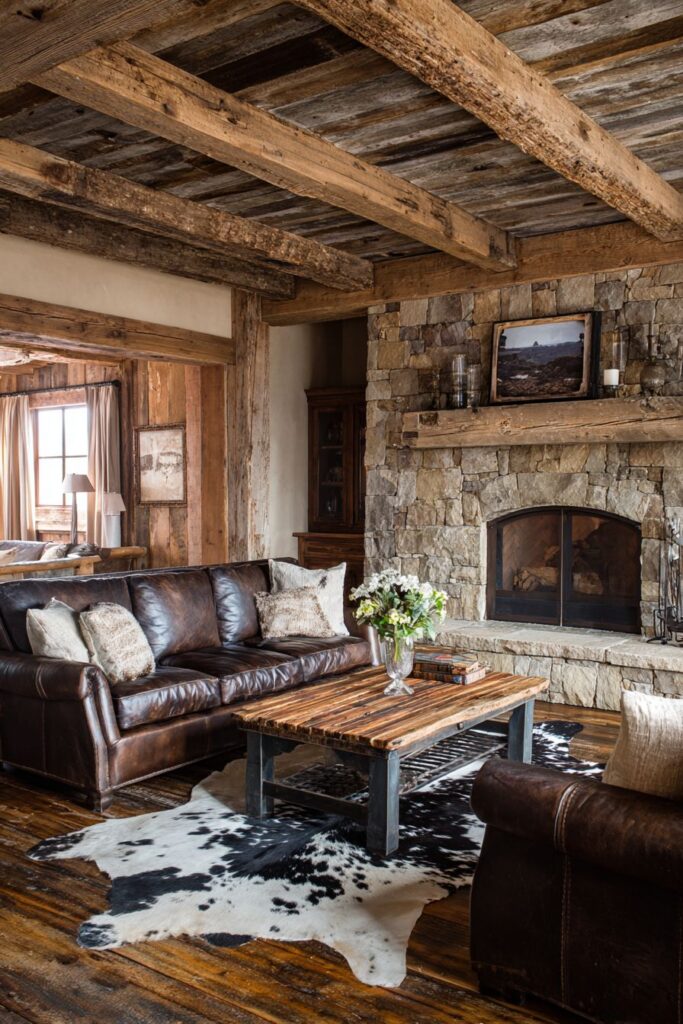
The reclaimed hardwood floors with visible nail holes and weathering bring architectural history into the living space, using materials that have already lived full lives in previous structures. These floors tell stories through their imperfections while providing durability that can last for centuries with proper care. The nail holes and wear patterns add texture and visual interest that manufactured flooring cannot match.
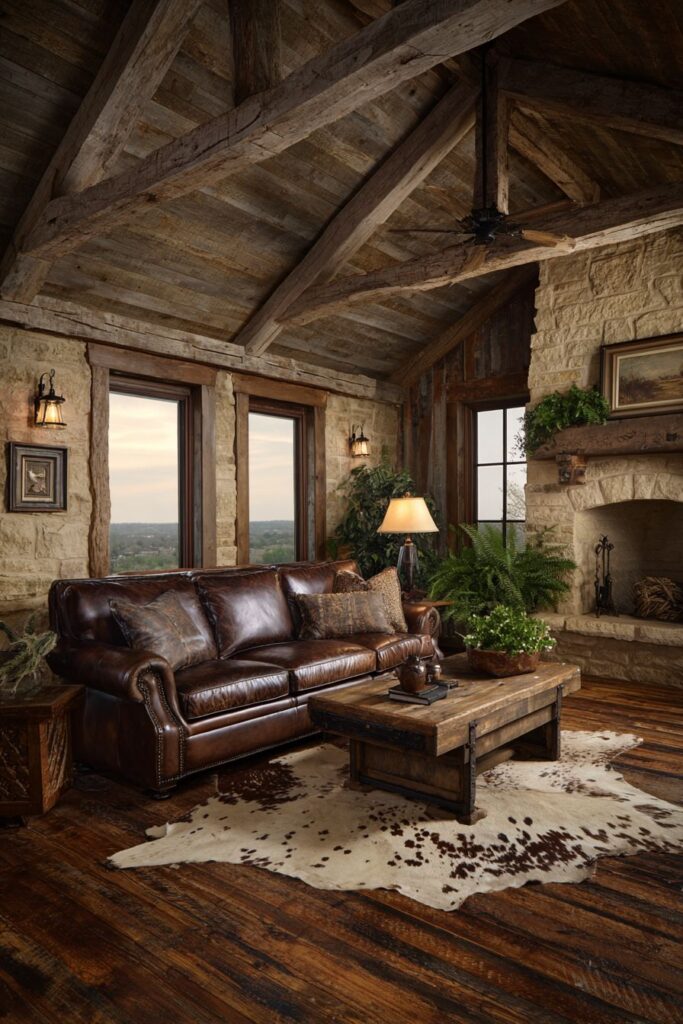
The coffee table made from a repurposed barn beam exemplifies rustic design’s commitment to sustainability and authenticity. This massive timber, originally cut to support agricultural buildings, now serves as functional furniture while retaining evidence of its previous life. The beam’s substantial presence grounds the seating area while its weathered surface provides textural contrast to the leather upholstery.
Exposed wooden ceiling beams reveal the home’s structural skeleton while adding architectural interest and rustic character. These beams, with their authentic construction details and natural wood grain, create visual rhythm across the ceiling plane while adding warmth and natural color to the room’s upper reaches. The rough-hewn stone fireplace mantel complements the ceiling beams while providing a substantial focal point that anchors the seating arrangement.

Key Design Tips:
- Choose materials that improve with age and use rather than deteriorating
- Incorporate reclaimed materials for both sustainability and authentic character
- Expose structural elements like beams to add architectural interest
- Use substantial, weighty furniture pieces to ground the space
- Celebrate imperfections and wear patterns as signs of authenticity
15. Coastal Tranquility: Bringing Ocean Breezes Indoors

Coastal design captures the relaxed, rejuvenating atmosphere of seaside living through natural materials, ocean-inspired colors, and design elements that celebrate connection to water and nature. The white linen sectional sofa with slip-covered cushions embodies coastal living’s emphasis on comfort, practicality, and easy maintenance. The slip-cover approach allows for seasonal washing and replacement, essential in environments where sand, salt air, and casual living are part of daily life.
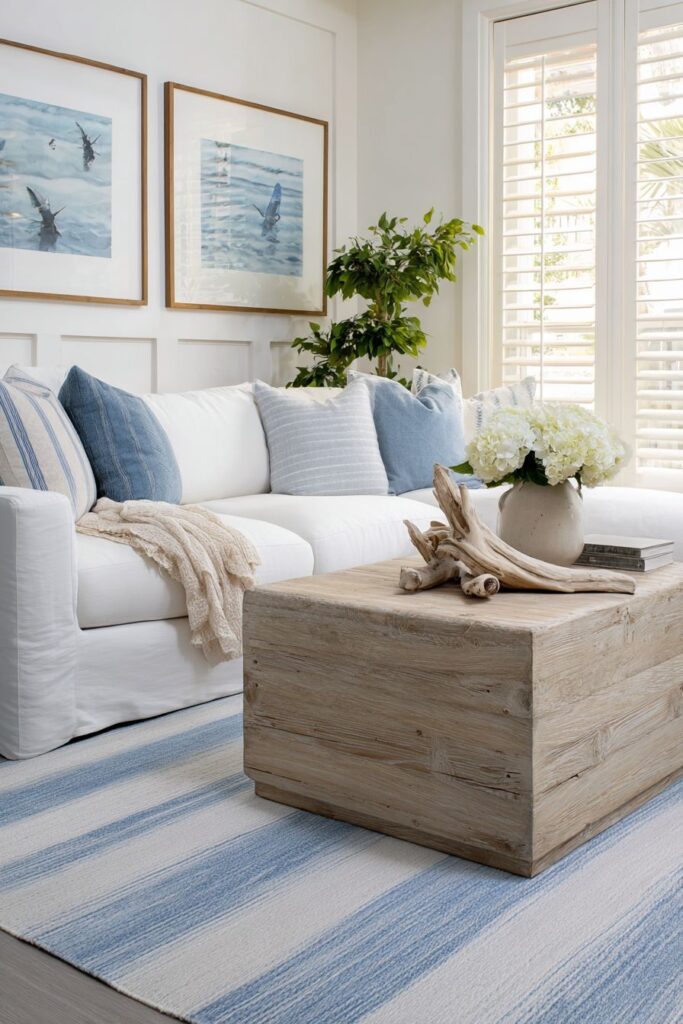
Natural cotton throw pillows in ocean blues and sandy beiges bring the coastal palette indoors while providing comfort and visual softness. These colors directly reference the seaside environment while creating a calming, restful atmosphere that promotes relaxation. The natural cotton fabric feels appropriate for casual coastal living while providing durability and easy care that busy beach life requires.

The weathered teak coffee table brings maritime materials indoors, using wood that’s naturally resistant to moisture and salt air. Teak’s natural oils provide protection from the elements while its weathered finish suggests years of exposure to sun and sea spray. This material choice connects the interior to nautical traditions while providing practical durability for coastal environments.
Shiplap walls painted in soft white reference traditional coastal architecture while providing subtle texture that plays beautifully with natural light. The horizontal lines of shiplap construction create visual width while the white paint reflects maximum light, essential in creating the bright, airy feeling associated with coastal interiors. Large windows with white shutters frame ocean views while providing practical storm protection and light control.

Key Design Tips:
- Choose fabrics and materials that can withstand moisture and casual use
- Use ocean-inspired colors like blues and sandy beiges for calming effects
- Incorporate weathered natural materials like teak for maritime authenticity
- Paint walls in whites and soft neutrals to maximize light reflection
- Install shutters for both practical storm protection and aesthetic appeal
16. Art Deco Glamour: Geometric Patterns and Luxurious Materials

Art Deco design represents one of the most distinctive and glamorous periods in decorative arts history, characterized by bold geometric patterns, rich materials, and sophisticated color combinations. The velvet sofa in deep emerald green with gold accent piping captures the era’s love of luxury fabrics and precious metal details. The emerald green provides dramatic richness while the gold piping adds the metallic accents that defined Art Deco’s opulent aesthetic.
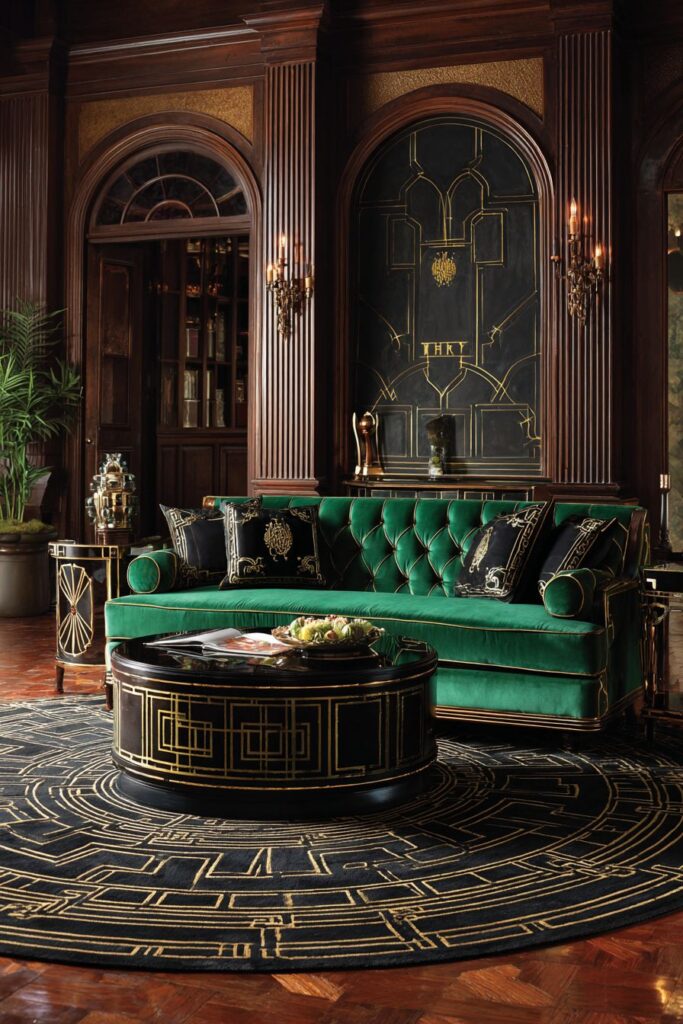
The black lacquered coffee table with metallic inlays exemplifies Art Deco’s sophisticated use of contrasting materials and geometric patterns. The high-gloss lacquer finish creates depth and reflection while the metallic inlays provide pattern and light-catching details that change throughout the day. This attention to surface treatment and detail work represents Art Deco’s commitment to craftsmanship and visual drama.

The black and gold geometric rug with authentic period patterns grounds the seating area while providing the bold patterning that defined Art Deco interiors. These patterns often drew inspiration from ancient cultures, machine age geometry, and natural forms interpreted through modern eyes. The high contrast between black and gold creates visual impact while referencing the era’s confidence and optimism about modern life.
Mirrored accent furniture and brass lighting fixtures reflect light throughout the space while adding the glamorous surfaces that Art Deco interiors required. Mirrors multiply both natural and artificial light while creating illusions of greater space and luxury. Rich wood paneling in dark walnut with gold leaf details adds warmth and luxury while providing the sophisticated backdrop that Art Deco rooms demanded.

Key Design Tips:
- Use bold, contrasting colors like emerald green and gold for dramatic impact
- Incorporate geometric patterns that reference the machine age and ancient cultures
- Choose furniture with high-gloss finishes and metallic details
- Add mirrored surfaces to multiply light and create glamorous reflections
- Use rich materials like velvet, lacquer, and gold leaf for authentic luxury
17. Reading Retreat: Creating Dedicated Literary Spaces

A dedicated reading nook within the living room recognizes that modern homes must accommodate quiet, contemplative activities alongside social functions. The comfortable accent chair in soft grey positioned near a large window takes advantage of natural reading light while creating a distinct zone for literary pursuits. The chair’s placement and orientation signal its intended use while maintaining visual connection to the main living area.
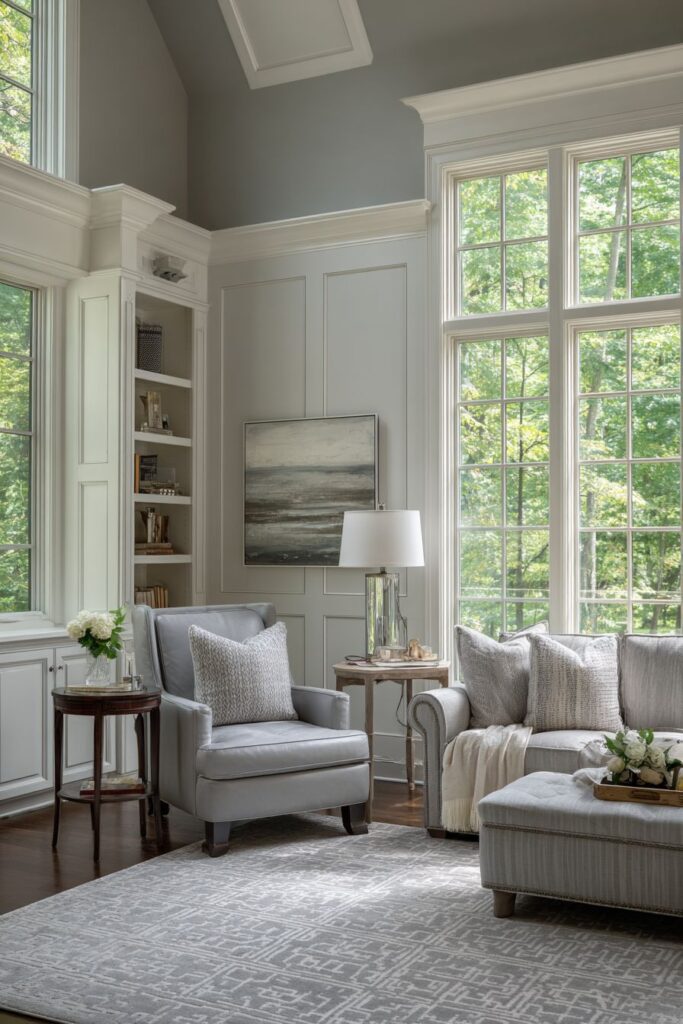
Built-in floor-to-ceiling bookshelves surround the reading area, creating an intimate library atmosphere that celebrates the written word. Adjustable shelves accommodate books of various sizes while allowing for the collection’s growth and change over time. The floor-to-ceiling height maximizes storage capacity while creating dramatic architectural presence that elevates books from mere storage to room decoration.

The small side table positioned within easy reach holds essential reading accessories – proper task lighting and personal items that support extended reading sessions. This attention to the practical needs of reading demonstrates how thoughtful design can enhance daily activities. The table’s size and placement are carefully calibrated to provide necessary surface area without interfering with the chair’s comfort or the reader’s movements.
The integration of the reading nook within the larger living space shows how contemporary homes can accommodate multiple functions without sacrificing style or comfort. The neutral color palette ensures the reading area harmonizes with the main seating while the furniture placement creates psychological separation for quiet activities. This approach recognizes that successful living spaces must balance social and solitary needs.

Key Design Tips:
- Position reading seating near windows for optimal natural light
- Install floor-to-ceiling bookshelves for maximum storage and architectural impact
- Provide convenient surface space for reading accessories and personal items
- Use furniture placement to create psychological separation for quiet activities
- Integrate reading areas with main living space through consistent color and style
18. Monochromatic Sophistication: The Power of Tonal Variation
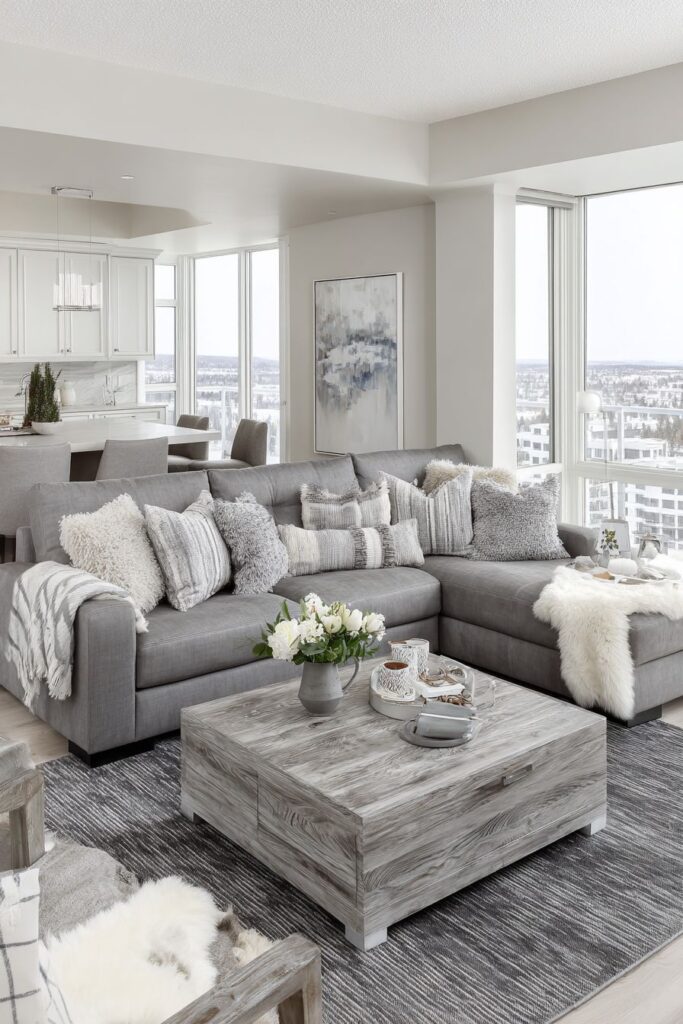
Monochromatic design demonstrates that sophisticated interiors can be created using variations of a single color, proving that visual interest comes from texture, proportion, and tonal variation rather than contrasting hues. The dove grey sectional sofa serves as the central element in a carefully orchestrated symphony of grey tones, providing comfortable seating while contributing to the room’s cohesive color story.
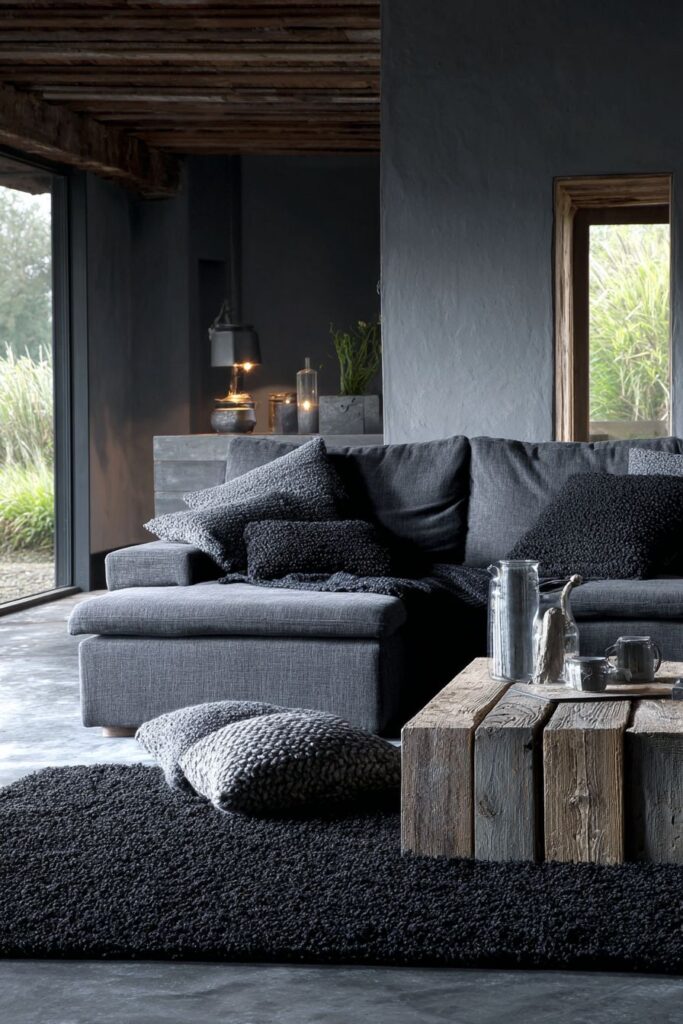
Different textured throw pillows in complementary grey tones add tactile interest and subtle visual variation while maintaining color harmony. These pillows demonstrate how texture can provide the visual stimulation that color contrast might otherwise supply. The varying textures catch and reflect light differently, creating subtle shadows and highlights that animate the monochromatic scheme throughout changing daylight conditions.

The charcoal wool area rug grounds the seating arrangement while providing the darkest tone in the room’s grey palette. This darker anchor prevents the light grey upholstery from appearing to float while defining the conversation area within the larger space. The wool texture adds warmth and softness underfoot while its substantial presence provides visual weight that balances the lighter furniture pieces.
The coffee table features grey-washed wood with natural grain visible through the finish, adding organic texture to the refined color scheme. The wood grain provides subtle pattern and natural variation while the grey wash maintains color consistency. Natural and artificial lighting reveal the subtle variations in grey tones and textures throughout the space, proving that monochromatic doesn’t mean monotonous when executed with attention to texture and tonal variation.

Key Design Tips:
- Use varying textures to create visual interest within a single color family
- Include both light and dark tones to create proper contrast and visual anchoring
- Add organic textures like wood grain to soften refined monochromatic schemes
- Consider how different lighting conditions will affect tonal relationships
- Choose high-quality materials that showcase subtle variations within single colors
19. Natural Stone Drama: Earth Elements as Architectural Features
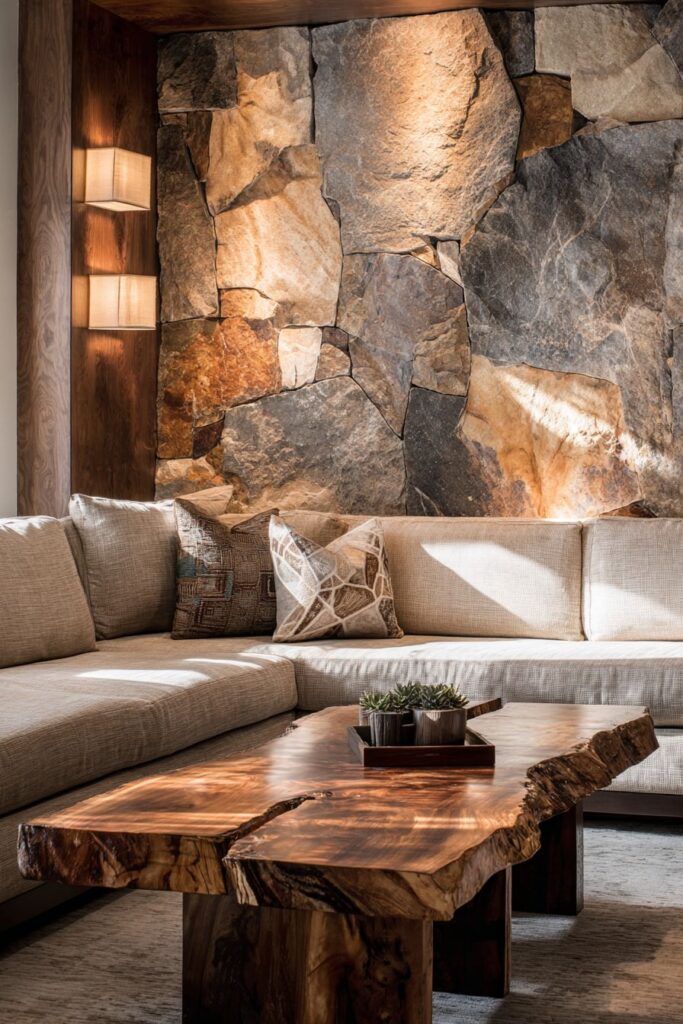
Natural stone veneer creates dramatic architectural impact while bringing the raw beauty of geological processes into refined interior spaces. The statement wall featuring natural stone in varying earth tones and textures serves as both art and architecture, providing visual weight that anchors the entire room composition. The natural variations in color, texture, and pattern create a unique installation that cannot be replicated, making each stone wall a one-of-a-kind architectural feature.
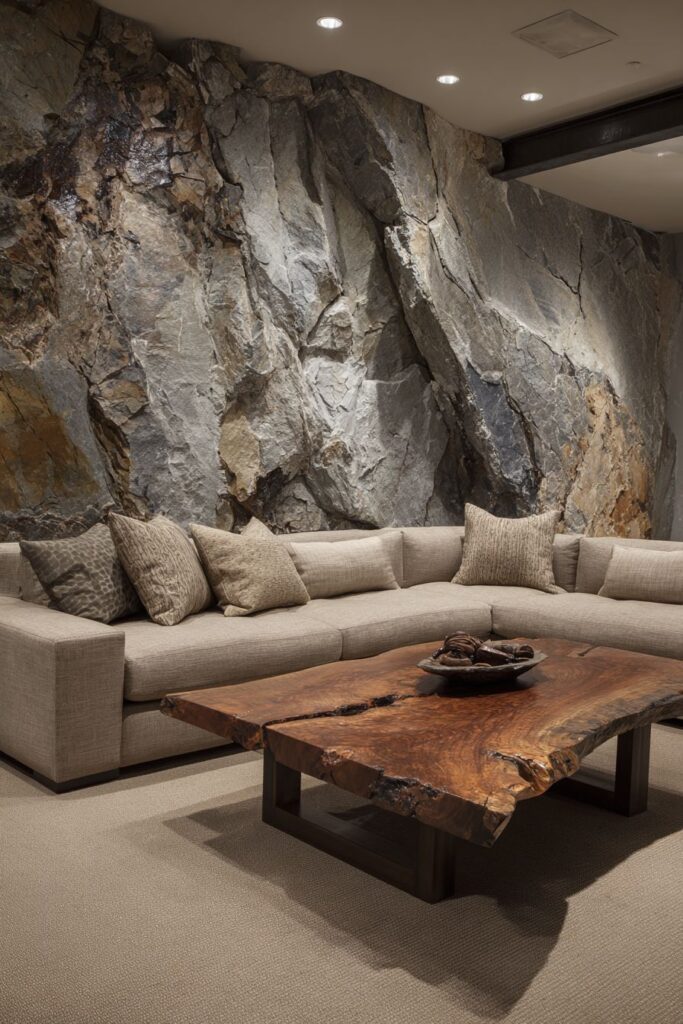
The neutral beige sectional sofa allows the stone wall to remain the focal point while providing comfortable seating that doesn’t compete with the natural drama. This restrained approach to furniture selection demonstrates how powerful architectural features require supporting elements that enhance rather than compete with their impact. The beige color harmonizes with the stone’s earth tones while providing neutral grounding for seasonal accessories and textile changes.
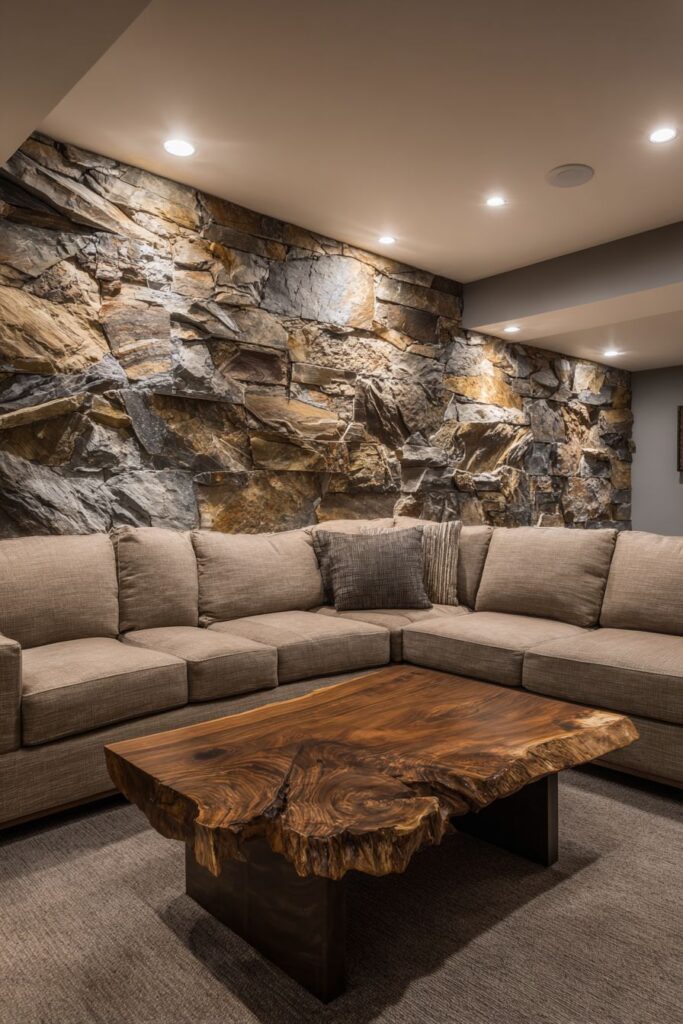
The live-edge wooden coffee table echoes the natural theme established by the stone feature while adding organic warmth to balance the stone’s harder surfaces. Live-edge pieces celebrate the tree’s natural growth patterns and create visual dialogue with the stone wall’s natural irregularities. Both materials showcase the beauty found in natural processes and geological time, connecting the interior to larger natural cycles.
Integrated lighting within the stone wall creates dramatic shadows and highlights that emphasize texture details and create visual depth. This lighting approach transforms the stone from a passive surface into an active architectural element that changes character throughout the day and evening. The carefully balanced lighting ensures the stone wall remains the room’s focal point while providing ambient illumination that enhances the overall atmosphere.

Key Design Tips:
- Use natural stone to create architectural focal points with unique character
- Choose neutral furniture colors that complement rather than compete with stone
- Add live-edge wood elements to balance stone’s harder surfaces with organic warmth
- Integrate lighting to highlight stone texture and create dramatic shadows
- Consider how stone walls will interact with both natural and artificial lighting
20. Family-Friendly Function: Style Meets Practical Daily Life
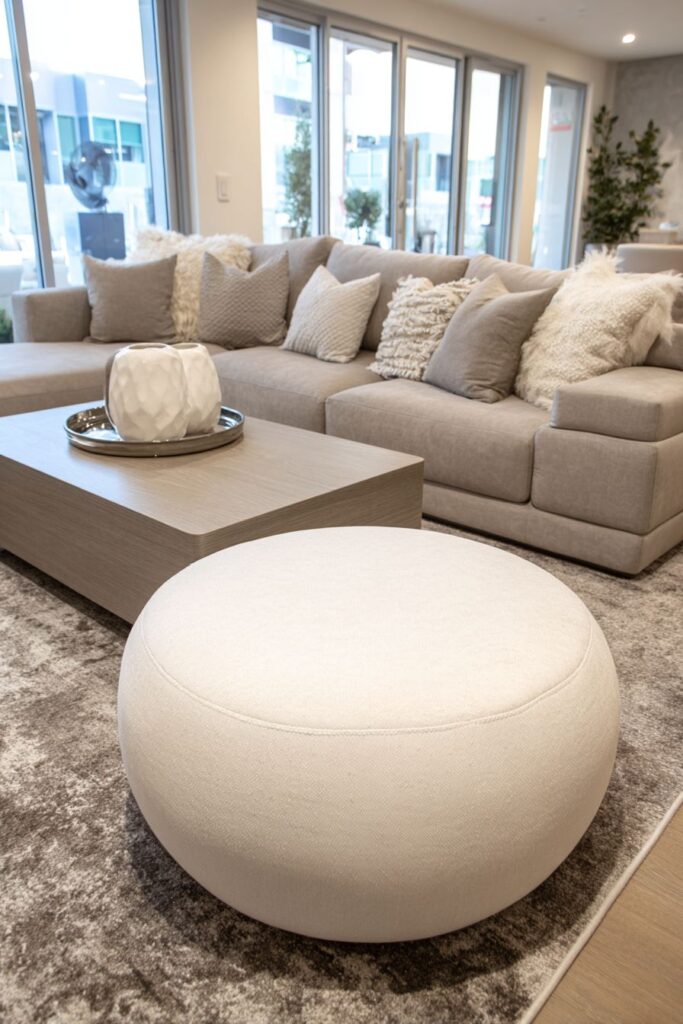
Modern family living requires spaces that can accommodate the chaos of daily life while maintaining style and comfort for all inhabitants. The sectional sofa featuring stain-resistant fabric and modular components addresses the practical needs of families with active lifestyles while providing the flexibility to reconfigure seating arrangements for different activities and gatherings. This modular approach recognizes that family needs change throughout the day and across different life stages.
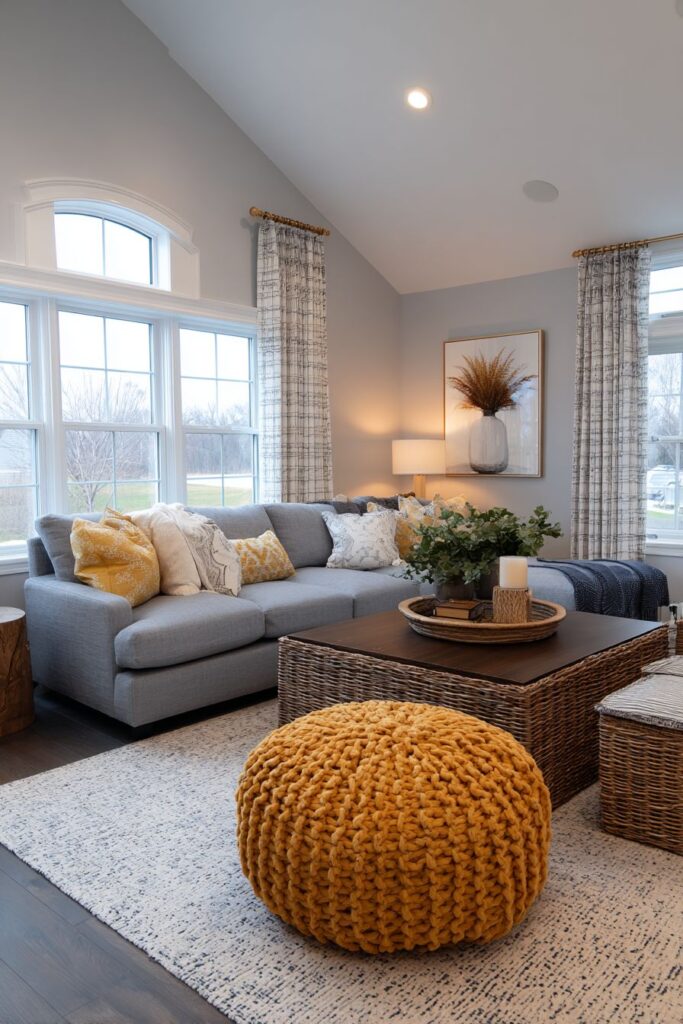
Storage ottomans serve dual purposes by providing additional seating when needed while hiding the inevitable accumulation of family items that don’t have designated homes. This hidden storage approach maintains the room’s clean appearance while providing practical solutions for toys, games, blankets, and other family essentials. The ottoman design ensures that storage remains accessible while contributing to the room’s seating capacity during gatherings.
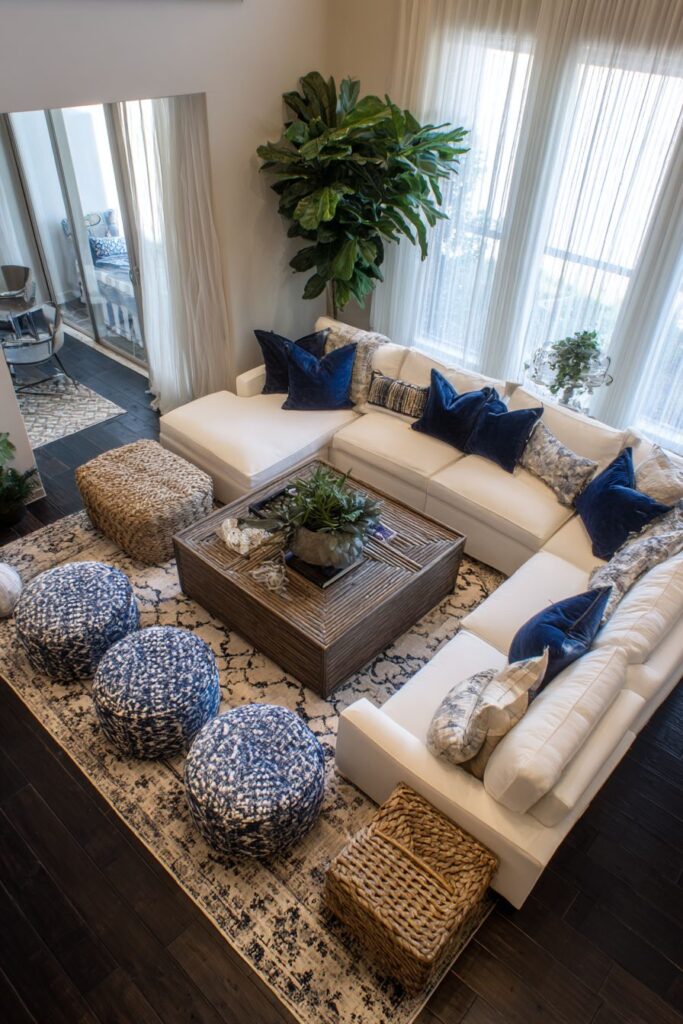
The large coffee table with rounded corners ensures child safety while providing ample surface space for family activities, homework, games, and dining. The rounded corners eliminate sharp edges that could cause injury during active family life while the substantial size accommodates multiple simultaneous activities. This attention to safety considerations demonstrates how family-friendly design can maintain style while prioritizing practical concerns.
Built-in charging stations and cord management systems integrate modern technology needs seamlessly into the room’s design. These systems recognize that contemporary families require multiple device charging locations while maintaining clean, uncluttered appearances. Durable yet stylish flooring and washable area rugs accommodate the wear and tear of active family use while maintaining the room’s attractive appearance over time.
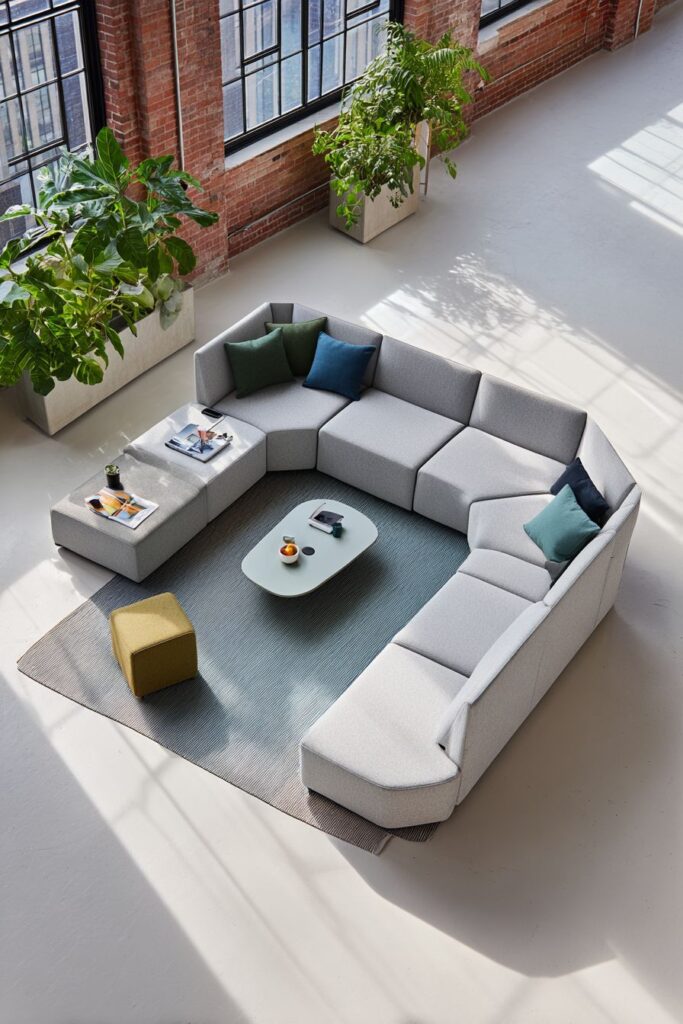
Key Design Tips:
- Choose stain-resistant fabrics that can withstand heavy family use
- Incorporate modular furniture that can adapt to changing family needs
- Select furniture with rounded edges to ensure child safety
- Include hidden storage solutions for family items and toys
- Install charging stations and cord management for modern technology needs
Why These Living Room Designs Represent the Best in Contemporary Interior Style
These twenty living room concepts represent the pinnacle of contemporary interior design because they successfully balance aesthetic appeal with practical functionality while addressing the diverse needs of modern living. Each design approach offers unique solutions to common living space challenges, from maximizing small spaces to creating dramatic focal points, from accommodating family life to creating sophisticated entertaining areas.
The Scandinavian serenity design exemplifies the best of minimalist living by proving that simplicity doesn’t mean sacrificing comfort or beauty. This approach has gained international recognition because it creates spaces that feel both calming and energizing, sophisticated yet approachable. The emphasis on natural materials and abundant light addresses modern desires for sustainability and wellness while creating timeless spaces that won’t quickly become dated.
Modern minimalism takes restraint to its logical conclusion, creating spaces that feel both luxurious and serene through careful attention to proportion, material selection, and spatial relationships. This design philosophy has become increasingly popular as people seek refuge from information overload and visual chaos in their daily lives. The clean lines and uncluttered surfaces provide psychological rest while the high-quality materials ensure lasting satisfaction.
The traditional warmth approach proves that classic design elements remain relevant in contemporary homes when executed with attention to comfort and livability. This design concept succeeds because it addresses fundamental human needs for comfort, beauty, and connection to cultural heritage while incorporating modern amenities and lifestyle requirements. The layered lighting and rich materials create spaces that feel immediately welcoming and permanently satisfying.
Industrial edge design celebrates the beauty of honest materials and functional elements, creating spaces that feel both urban and sophisticated. This aesthetic has gained popularity because it speaks to contemporary values of authenticity and sustainability while creating dramatic spaces that make strong style statements. The combination of raw materials with refined furniture creates visual tension that energizes spaces while maintaining comfort and livability.
The mid-century modern revival demonstrates how historical design movements can be reinterpreted for contemporary living without losing their essential character. This style remains popular because it successfully combines bold design choices with functional planning, creating spaces that feel both distinctive and livable. The integration of indoor and outdoor living addresses contemporary desires for connection to nature while the bold colors and organic forms create visually stimulating environments.
Small space solutions have become increasingly important as urban living requires creative approaches to space planning and furniture selection. These designs succeed because they prove that spatial limitations don’t require compromising style or comfort when approached with creativity and strategic thinking. The multifunctional furniture and clever storage solutions address practical needs while maintaining visual appeal and spatial flow.
Bohemian eclecticism celebrates individuality and cultural exchange, creating spaces that feel deeply personal while maintaining sophisticated design principles. This approach appeals to contemporary desires for unique, non-corporate spaces that reflect personal interests and global awareness. The layered textures and mixed patterns create visually rich environments that encourage creativity and self-expression.
Farmhouse charm addresses contemporary longings for simplicity, authenticity, and connection to traditional values while incorporating modern comfort and convenience. This style has gained widespread appeal because it creates spaces that feel both sophisticated and approachable, formal enough for entertaining yet comfortable enough for daily family life. The natural materials and casual elegance appeal to contemporary desires for authentic, sustainable living.
Contemporary drama proves that bold design choices can create sophisticated spaces when executed with attention to proportion and material quality. These designs succeed because they create memorable spaces that reflect confident personal style while maintaining the flexibility necessary for contemporary living. The strategic use of color and geometric forms creates visual impact that energizes daily life.
Neutral sophistication demonstrates that refined spaces can be created without bold colors or dramatic contrasts, instead relying on texture, proportion, and material quality to create visual interest. This approach has gained popularity because it creates timeless spaces that serve as calming backdrops for busy contemporary lives while providing flexibility for changing decorative preferences over time.
These design concepts represent the best of contemporary interior style because they address fundamental human needs for comfort, beauty, and functionality while incorporating current lifestyle requirements and aesthetic preferences. Each approach offers tested solutions to common design challenges while providing opportunities for personal expression and adaptation to individual circumstances. The variety of approaches ensures that different personality types and living situations can find appropriate design inspiration while the consistent attention to quality and livability guarantees lasting satisfaction with the results.
Conclusion
The living room remains the heart of the contemporary home, serving multiple functions while reflecting personal style and supporting daily life activities. These twenty design concepts demonstrate that successful interior design balances aesthetic appeal with practical functionality while addressing the diverse needs of modern families. From the serene simplicity of Scandinavian design to the bold drama of Art Deco glamour, each approach offers unique solutions to common living space challenges.
The key to creating an exceptional living room lies in understanding how different design elements work together to support both daily activities and special occasions. Whether you’re drawn to the raw authenticity of industrial materials, the cozy comfort of farmhouse style, or the sophisticated restraint of monochromatic design, success depends on thoughtful selection of furniture, materials, lighting, and accessories that work together harmoniously.
Contemporary living demands flexibility, sustainability, and connectivity – requirements that all of these design approaches address through different strategies. Some emphasize modular furniture and hidden storage, others focus on natural materials and energy-efficient lighting, while still others prioritize indoor-outdoor connections and technology integration. The diversity of successful approaches proves that good design is not about following rigid rules but about understanding principles that can be adapted to individual circumstances and preferences.
As you consider implementing these ideas in your own home, remember that the most successful living rooms are those that reflect the personalities and lifestyles of their inhabitants while providing the comfort and functionality necessary for daily life. Start with a clear understanding of how you use your living space, then select design elements that support those activities while creating the atmosphere you desire. Whether you choose to implement a complete design concept or combine elements from several approaches, focus on quality materials, thoughtful proportions, and careful attention to lighting to ensure lasting satisfaction with your results.
The investment in thoughtful living room design pays dividends in daily comfort, entertainment success, and long-term property value. These spaces set the tone for entire homes while providing the backdrop for countless memories and experiences. By choosing approaches that balance beauty with practicality, tradition with innovation, and personal expression with universal appeal, you can create living spaces that enhance daily life while providing enduring satisfaction for years to come.
